Review: Tovala Steam Oven With Tovala IQ
WIRED—December 12, 2018

I get a little flush of excitement every time I receive a box of kitchen gear that I’ve called in to test. They are always items I’m curious about and ones that have the potential to change the market or, more importantly, improve the way we cook at home.
That familiar feeling returned to me with the arrival of the Tovala, a countertop oven with an app and an optional meal kit subscription. The oven has a few different modes: toast, bake (convection bake, technically), reheat, broil, and the mysteriously seductive steam. Taken together, the oven’s capabilities could crush it in multiple categories, potentially wiping out the need for a toaster, toaster oven, and air fryer, all while making life easier with that meal kit service.
Read my WIRED review to find out if they were up to the task.
My Favorite Cookbooks of 2018
WIRED—November 18, 2018
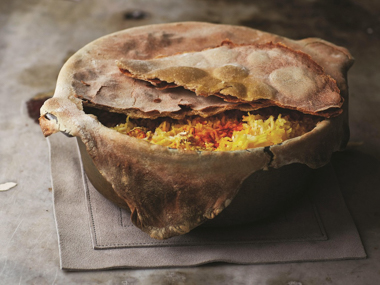
In this zinger of a year, food’s role in our lives felt like it shifted every day. Cooking at home became more of an oasis than ever, a meal with friends somehow more important. Some nights, though, punting and ordering takeout was not a copout but a necessity. This year’s best books reflect this whipsawing, whether it’s about saving the world (or just a part of it), understanding it a little better, encouraging us to take a load off and pour a nice drink, or just tell us what to do because one more decision was one too many. We’re still hungry, though—more than ever!—and these are the books that reflect our appetites.
Read about my favorite books in WIRED.
The Pie of the Future Is Baked With Freeze-Dried Ingredients
WIRED—November 17, 2018

High-end chefs spend a lot of time figuring out how to get foods to taste their best. Are they seasoned correctly? Is there a balance between fat and acidity that makes you want more? Is there a way they could pull off the ultimate feat of making a food taste more like itself?
Using the trick I’ve just learned from rising-star chef Eric Rivera, you can up your holiday game rather easily and I’m willing to share it: using powdered freeze-dried foods to amp up the flavors in your favorite recipes.
Find out how to do it in my latest story for WIRED.
Review: AmazonBasics Microwave
WIRED—November 14, 2018

Moments after plugging in Amazon’s new Alexa-connected microwave I was about to review, the first thing I noticed was the word that popped up on its screen: FAIL. It hadn’t—it had just jumped the gun a bit in the connection process, but that word hung over the testing process in surprising ways.
The AmazonBasics Microwave is a 700-watt, 0.7-cubic foot appliance that costs a mere 60 dollars and connects with Amazon devices like the Echo, allowing you to control many of the microwave’s functions with your voice. Say “Alexa, microwave 30 seconds” and the appliance starts whirring away on high. Trying “Alexa defrost ten ounces of fish” will result in more-regulated microwave blasts. For many functions, it’s very similar to GE’s new Smart Countertop Microwave with Scan-to-Cook Technology, though that oven has the additional ability to scan the bar codes of thousands of microwaveable products and deliver cooking instructions to the oven.
Clever as it sounds, I never quite saw the value add of the Scan-to-Cook, but was curious and excited about Amazon’s first foray into kitchen hardware.
The question that kept nagging at me, though, is, ‘If you have to go to the microwave to put your popcorn inside, and it only takes .2 seconds to press the popcorn button, do we need to be able to talk to our microwaves?’
Read the full review and find out in WIRED.
Review: Cuisinart Extra-Large Rotisserie Fryer and Steamer
WIRED—November 4, 2018
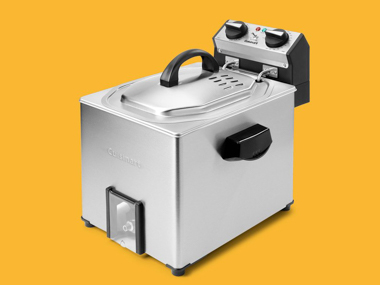
Deep-fried turkey is an exciting Thanksgiving menu sub-genre, bringing new flavors—and risk!—to the traditional holiday feast. To fry a turkey in the now-classic way, you hook a propane tank to a large, stand-alone burner, heat a giant vat of oil on top of it, then rely on arm strength to lower your bird into the scalding oil and hope to not make a splash. It cooks remarkably quickly and some people swear by the crisp skin and juicy meat, but damn, there are some downsides, not the least of which is that they’re dangerous enough to have spawned their own sub-genre of flaming-turkey-fryer disaster videos.
So when Cuisinart put their name on what had been a Waring fryer after Waring dumped their consumer line in 2014, I was intrigued. Their Extra-Large Rotisserie Fryer and Steamer is essentially a large, electric countertop frying vessel where only the bottom third is filled with oil. You lower a bird on a spit into the box and a set of gears constantly rotates the spit, meaning only the lower third or so of the turkey is in the fry oil at any time. You can also remove the spit, switch over to a basket, and use the setup as a traditional deep fryer.
Read my full review and figure out if this is the machine for you.
The Mad Science of Fermentation’s Funky Flavors
WIRED—October 23, 2018

More people across the US are making their own kimchi and sauerkraut, brewing kombucha in their kitchens, and working fermentation into their everyday cooking. In the recently published book The Noma Guide to Fermentation, from the famous Copenhagen restaurant, chef René Redzepi and Noma’s fermentation lab director, David Zilber, have created an indispensable manual for home cooks and pro chefs interested in exploring this growing trend.
Read the whole story in WIRED.
Get Yourself the Right Cookware to Maximize a Small Space
WIRED—October 23, 2018
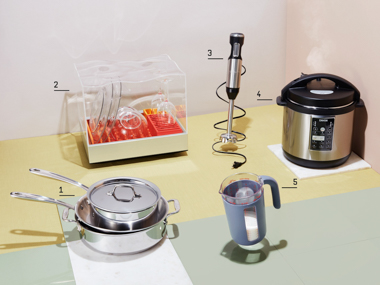
Renting a tiny room in Nob Hill for too many dollars a month? From a brand-new pressure cooker that might be better than your Instant Pot, to a pan set that stacks without becoming an annoying, wobbly tower, to a tiny dishwasher that sits on your countertop, this gear helps you make space for cooking.
Read the story in WIRED.
Brew a Perfect Pot of Coffee With Bodum Mocca’s Beam Heater
WIRED—October 23, 2018
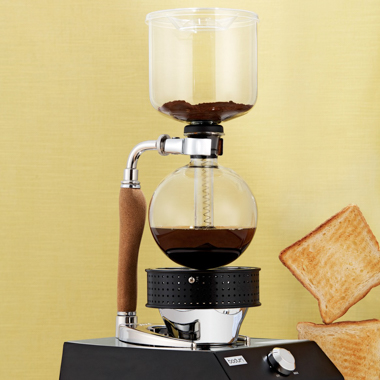
Making coffee is a science, so brew it in something that looks like it’s on loan from a chem lab. Siphons—also called vacuum pots—traditionally use butane heat sources. Bodum’s Mocca instead uses the red-hot glow of a 430-watt halogen Beam Heater to bring the water to just below boiling. Pressure from the heat forces the liquid up into the hopper, where it mingles with the grounds. Switch the heater off after four minutes, and the brewed coffee passes through a filter and back into the globe. The result is a well-rounded brew with the toastiness of French press, minus the grit. Like your cuppa cooler? Use the control knob to fine-tune the temperature you desire. After brewing, the heater can also be used to keep the coffee warm above its seductive glow. It’s part science, part magic, and full-fledged after-dinner theater.
Read the full story in WIRED.
Review: The Noma Guide To Fermentation
WIRED—October 19, 2018

Occasionally, when shredding cabbage to make sauerkraut, I wonder, of all vegetables, why this one? Don’t get me wrong—little makes me happier than a late-night snack of beer, cheddar, crackers, and kraut, but the popularity of the lowly cabbage for fermenting always felt weirdly limiting.
It wasn’t for lack of great teachers. For the last few years, I’ve enjoyed working with the genius cheerleader Sandor Katz’s Wild Fermentation in one hand and the bulletproof straight shooting of America’s Test Kitchen’s Foolproof Preserving in the other. Somehow, though, the two left me tradition bound, and I never ventured beyond sauerkraut and kimchi. I needed some uncharted territory.
I found it in Rene Redzepi and David Zilber’s new book, The Noma Guide to Fermentation—read my WIRED review here.
Review: Hestan Smart Induction Cooktop
WIRED—October 13, 2018
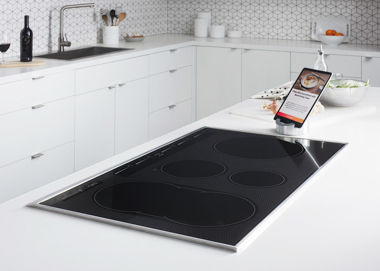
The first thing I did with the new stovetop in front of me was the simplest and the most important. I set the burner to a temperature, set of pound of butter in a pan and walked away for 20 minutes. When I returned, I skimmed the foam from the surface and poured out perfect clarified butter.
The chefs among you might notice the lack of baby-sitting that process entailed. No stopping back to make sure it wasn’t burning, no realizing the heat was set too low, no fussing whatsoever. That’s thanks to being able to set the burner to an exact temperature, in this case 240 degrees Fahrenheit, something heretofore inconceivable in built-in cooktop. This means you can do stuff like temper chocolate, caramelize onions, or slowly cook ultra-tender scrambled eggs without fear. Or, you can sear a steak without worrying if your burner’s definition of medium-high is the same as the recipe writer’s in the cookbook you’re reading. You can do it all with a tested number and not a feeling.
For the brand-new Smart Induction Cooktop, Hestan supplements this impressive offering heavily, with hundreds of chef-created, tested recipes, along with in an app that walks you through every step.
Read my complete review in WIRED to find out if Hestan’s connected cooktop is worth its salt.
Review: PK360 Grill & Smoker—A Solidly Built Grill/Smoker Combo With Excellent Temperature Control
WIRED—August 18, 2018
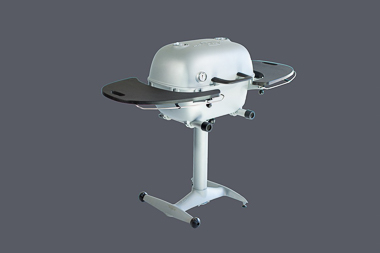
It may have arrived at my home in a box delivered by FedEx, but from the moment I saw it, I wondered if the grill I was testing hadn’t been shipped directly from the set of some 1960s sci-fi television series.
Like no grill I’ve ever seen, the PK360 Grill & Smoker by PK Grills is a cast-aluminum clamshell perched on a base that may have been inspired by the octopods from Arrival. Two semi-elliptical tables clamp firmly onto the sides, a wire rail around them giving the whole thing a “rings of Saturn” look.
As visually striking as it is, the most impressive feature of this grill is the clear amount of thought that went into its creation. As I assembled it, then cooked one tasty meal after another, I kept imagining a circle of designers and engineers sitting around and puzzling their way through problem after problem: How can we clamp the lid down tight and position vents to help hold the temperature steady during long cooks? How can we make this an effective grill and smoker? How can we reengineer a hinge?
What they came up with melds some of the best characteristics of charcoal grills and smokers.
To learn more about my new favorite grill, read on in WIRED.
Review: GE Smart Countertop Microwave With Scan-to-Cook Technology
WIRED—August 13, 2018

The first thing that struck me about the mass-market microwave that connects to the internet is how peculiar the machine’s diet is.
The GE Smart Countertop Microwave with Scan-to-Cook Technology is, despite the mouthful of a name, fairly unassuming to look at. It’s nearly identical to the slightly tinier, hardworking GE JES1072SHSS that I own. Yet this new, .9 cubic-foot, 900-watt microwave comes packed with high-tech features: You can use an app to scan the bar code on the back of your Hot Pockets to set the cooking time on the microwave. If you’ve got an Amazon Dot, Echo, or Show, you can do important things like turn it on and off or thaw chicken with your voice.
Is that important? Are you dubious, too? Read on in WIRED and see how GE’s latest stacks up.
Presto Nomad Review: It looks like a cooler, but it’s a slow cooker that’s made to travel.
WIRED—July 26, 2018

In 2005, my friend Mike bought an old and unreliable Infiniti G20 sedan in England for the equivalent of $750, did some emergency repairs, then drove it across Europe and down to Senegal. That was a long time ago, and now that I think of it, I wonder if he ever showered on that trip. But he recently took one look at the slow cooker I was reviewing and immediately wished out loud that he’d had it with him.
“We had a plug in the back,” he said, reminiscing about cooking eggs on the radiator and eating uncooked ramen noodle packs. “This would have been perfect.”
Mike and I were marinara-making, getting ready to enjoy the kind of deep-flavored food you can make simply by letting something cook quietly over the course of the day. The appliance we used worked like an old-school slow cooker, but it looked like none I’d ever seen.
To learn more about the funky, new Presto Nomad, read on in WIRED.
Review: Instant Pot Max—This Powerful Instant Pot Can Get Dinner To The Table Faster, In Theory.
WIRED—July 21, 2018
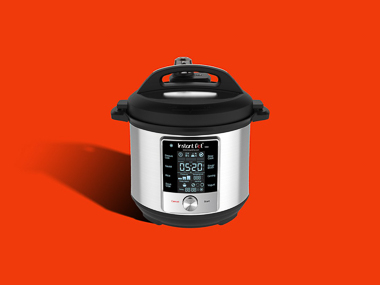
Electric pressure cookers hit it big in American home kitchens a few years back because, along with the perceived lower risk of dinner on the ceiling, they cook food fast. Something like beef stew, which takes all day in a slow cooker, needs as little as 25 minutes under pressure. With an extra hit of power, Instant Pot’s new six-quart Max promises to take that speed and turn it up to 11, getting dinner to the table even faster.
Could it? I wondered. And what’s 11 mean, anyway?
Like many other electric “multicookers,†the Max has several functions beyond pressure cooking including browning, slow cooking, steaming, rice-cooking, and yogurt-making. Like a few fancier models, it can cook sous vide, though due to the size of the cooking pot, that’s of pretty limited utility. The big difference is that until now, electric models struggled to achieve 15 psi when pressure cooking, the way old-school stovetop pressure cookers could. Without that extra bit of pressure, electric pressure cookers couldn’t get quite as hot, and recipes took a little while longer than they did in stovetop models.
Now with 1,100 watts (compared with Instant Pot’s traditional 1,000 watts), the Max says, “No more!†It hits 15psi and gets dinner cooked an estimated 10 to 15 percent faster. It’s caught up to your grandma’s stovetop pressure cooker! It’s not as big a deal as the hype preceding the Max, but it’s a nice, solid step forward. For now, it’s only available in a standard 6-quart size and you’ll pay a premium—$200—for the improvements.
Were my tests tooo much for the new Instant Pot? Read on to see if it cracked under pressure…in WIRED.
Five Pieces of Primo Meal-Prep Gear for the Campsite Gourmet
WIRED—July 6, 2018
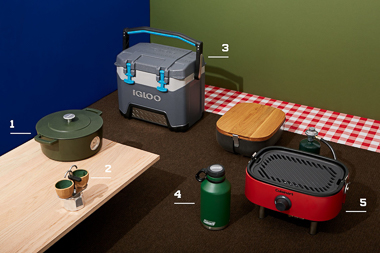
From a Dutch oven made in Holland to a two-cup espresso maker, to a stainless steel growler, here’s some choice equipment for cooking like a pro in the wild. Toss the packets of dehydrated soup and make a real meal at the campsite instead.
Check ‘em all out, and satiate your campsite gourmet by reading on in WIRED.
Kilner Fermentation Set Review: This cheap and easy-to-use kit is what you need to start fermenting
WIRED—June 28, 2018

There’s a point when I make sauerkraut where it feels like the whole thing is going off the rails. Mine has the traditional cabbage and caraway seeds, but I like to throw an onion in there and something about the latter steers the whole thing into off-putting deep-funk territory at about the six-day mark: it smells vaguely of stinky shoe and has a taste that’s equally prohibitive. Amazingly, these are not bad signs. Instead, they mean that in just a few more days, everything will click into place and I’ll soon be making a late-night snack of bread, cheese, beer, and sauerkraut that leaves me giddy.
Turns out that many fermented foods have this happy effect on me. So much so that while it took two decades of adulthood before I started making them myself, they’re now a part of my repertoire. Most of the time, I have a jar of sauerkraut or even kimchi fermenting away on a cool shelf, and another ready to eat in the fridge.
I like fermenting for a few reasons: the meditative chopping of a pile of vegetables, tasting the food as it evolves, and the day it hits that “holy cow” level of goodness when I slide it into the fridge for storage. I also love that the lowly cabbage—the unlikely star of the fermented world—can be transformed into something so exciting. If you’re in it for more than just great flavor, there are also a host of purported health benefits you may wish to explore.
Yet there are obstacles to making fermented food that you don’t usually run into with cooking, mostly because fermenting is a weird blend between steering the ship and not knowing exactly where it’ll end up.
To learn what I found to help steer the ship, read on in WIRED.
Review: Meater—This Wireless Thermometer Pings Your Phone When The Rib Eye Has Reached Perfection
WIRED—June 10, 2018
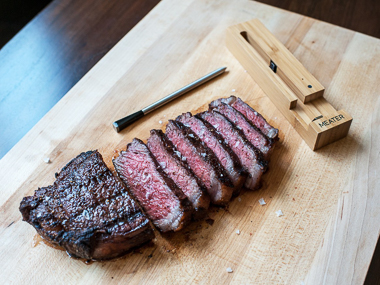
If it was up to me, my ideal grill would be one that could capably cook low and slow and and also be able to turn on the jets for a hard, fast sear. There’d be a nice-sized table next to it and space for my tools. The icing on the cake would be temperature control. For that, I’d want a little base station connected to a two-probe thermometer so I could monitor both the air temperature just above the grill grates and the internal temperature of the meat, with the data from both plotted out on a graph so I could understand what was cooking.
That whole thermometer thing seem a bit too much for you? Consider reconsidering. Thermometers, particularly modern digital thermometers, are the most important grill accessory you can own. Don’t you love fish at the point just past translucence, your pork chop slightly pink in the center, your lamb rosy, and your brisket luscious? The only way to do it all consistently is with a thermometer. Some people say they can poke a steak with a finger and know if it’s done, but I’m not one of them and those people are not always correct. It might sound silly, but I’ve been known to use thermometers on sausages because they taste better when they’re cooked just right. Not only do thermometers save pricey food from an overcooked fate, but you also get compliments when your food is cooked perfectly.
Are you tempted to buy this new wireless grill thermometer? Read on in WIRED to learn why you shouldn’t.
Essay: You Need A New Kitchen Knife
WIRED—May 18, 2018
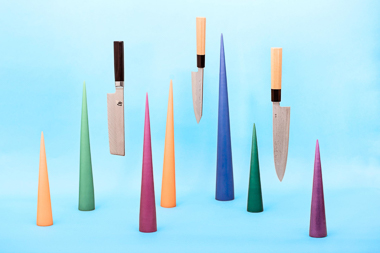
If you do a bit of kitchen knife research, you will soon discover a recurring theme, as well as some odd advice. The recurring theme is that the three key knives everyone must own are a chef’s knife, a paring knife, and a bread knife. The odd advice is after those three, what you choose to add to your collection is personal. As someone whose job it is to definitively point people toward the best next thing, this “personal choice” business is disconcerting. Also, it’s true.
This came up because I’ve been test driving three exciting new knives—one from Shun and two from Kikuichi Cutlery. The Shun is a dual-core nakiri, a rectangular, glistening beauty designed to make quick work out of vegetables. The two offerings from Kikuichi Cutlery are a Japanese take on a Western-style chef’s knife known as a gyuto, and a six-inch bunka which resembles a santoku with a more aggressive snout.
Do you really need a new knife? Read on and find out in WIRED.
Essay: Are Air Fryers Worth It?
WIRED—May 10, 2018
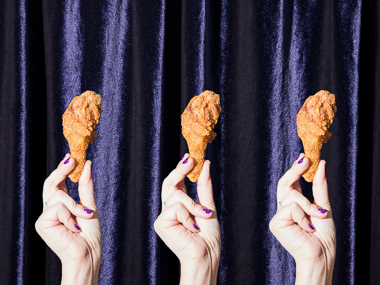
I called in one of Philips new XXL models, which is both large and a good representative of the best of the industry’s offerings.
It arrived in the morning and, lacking other options in my fridge and pantry, I made baked potatoes for my wife Elisabeth and myself. Pulling the air fryer out of the box, three things became immediately apparent. First, these things take up a lot of counter space—pretty much the footprint of a five-gallon bucket, and two-thirds the height. (Other brands might be smaller but not that much.) Second, the fan that that runs whenever it’s on is loud, effectively sucking the conversation or ambient music right up into the ether. The third thing was how ridiculously tiny the cooking basket is; at nine inches by nine inches by two and three-quarter inches high, two large potatoes effectively maxed out its capacity.
The spuds were good but that was more of a sour cream, cheddar, and chives thing than an air fryer thing. Clearly, more testing was in order.
I’ll warn you now, it’s not looking good for air fryers. If you’re considering one, though, read on and let me convince you to save your pennies in WIRED.
Essay: A Young Chicago Chef Pursues Wood-Fired Perfection
WIRED—April 17, 2018
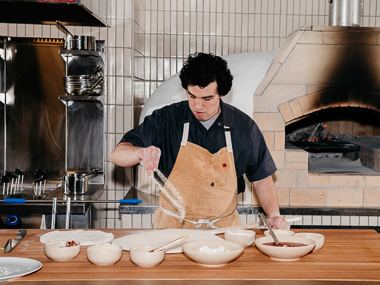
The James Beard Awards are often referred to as the “Oscars of the food world,” and while Chicago chef Erling Wu-Bower has been nominated for three of them, he’s lost all three.
“I’m like Susan Lucci!” he jokes, referring to the soap opera star who didn’t pick up her first Emmy until she’d earned her 19th nomination.
At the Windy City’s Experimental Station, a space which Wu-Bower uses as a test kitchen and where he hosts pop-up dinners, he gives me a preview of the food that will end up on tables at his soon-to-open restaurant, Pacific Standard Time. There will almost certainly be more nominations in his future, but really, I just want to be there when the doors open.
PST’s opening will mark a big departure for the chef; he’s switching from jobs where he was a precision-cooking disciple to work with notoriously fickle wood-fired hearth and pizza ovens.
“I’ve done the precise thing,” he says, referring to sous vide cooking. “You embrace technology so as not to waste money.”
Finds Erling Wu-Bower’s sweet spot between tech and touch, read on in WIRED.
Review: A New Cookbook Takes Us Deep Into the World of the Instant Pot
WIRED—April 12, 2018
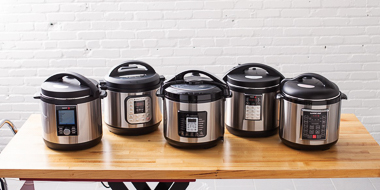
A few years back, in that now-forgotten time before Instant Pots were a thing, I reviewed an electric pressure cooker and struggled mightily with it. It was supposed to be a safe, fast way to speed up cooking and promised to make slow-cooker style dinners appear in a heartbeat. Unfortunately, stovetop pressure cooker cookbooks didn’t really work for their slightly-less-powerful electric counterparts, and this one came with a mini-cookbook with recipes that tended to flop.
Flash forward to last fall when Instant Pot Mania was in full swing and I put the company’s Ultra cooker (a souped up version of their classic Duo) at the top of my Christmas list. Once I popped it out of the box, though, I quickly realized that sub-par manuals and not-so-great included recipes are par for the course.
Turns out that Instant Pot is notorious for this, so much so that it’s rumored to be reworking its manuals. The Instant Pot Community group on Facebook is too much of a jungle for beginners, and while my friend Lylah secured an invitation for me to Facebook’s secret Instant Pot for Indian Cooking group, it was clearly over my head.
While there is a mushrooming number of electric pressure cooker cookbooks out there (many with those awful, mansplainy covers), it’s hard to know which one will allow you to kick the tires and give you the foundation you need to bring this new tool into heavy rotation in your kitchen while making tested, tasty recipes.
Yet here we are with our own electric pressure cookers, or, more precisely, “multicookers” (they also do things like sauté and slow cook), and our excitement to make everything we can in them, and I was still missing the manual I needed.
I tell you what, friends, I found the book. Read on for the full story in WIRED.
Review: SideChef—The Guided-Cooking App Has Thousands Of Recipes, But Needs An Editor.
WIRED—March 20, 2018

The other day at my mother-in-law’s house, I roasted a chicken in her 20-year-old oven and, at one point, turned on the oven light with the flick of an analog switch. There were no beeps, no series of buttons to press, no app to fire up, just a pleasing click and immediate light on the bird. Similarly, I used one knob on the oven to select “Bake,” and another to dial up the temperature. Everything happened quickly to get dinner rolling, making it a weirdly refreshing analog experience.
Many apps on the market now look to make cooking a connected experience. Sometimes, as in the case of the ThermoWorks Smoke thermometer it just makes sense—an app that connects to a hardware gadget can help you understand what’s happening with whatever you’re cooking. A good recipe app like the New York Times Cooking app can provide a convenient way to figure out dinner on your commute home. A fair amount of the time, an app adds little to no value to the experience, leading me to question why companies bother.
SideChef, an app with a supporting website, lands in the middle of this thicket. It features thousands of recipes with step-by-step photos or videos to guide you through them. Some are created in-house, but most come from contributors with blogs and websites that are linked to atop each recipe. Embedded techniques—from boiling water and dicing a pepper to more advanced options—are often there if you need a quick refresher course. The recipes scale up or down with the press of a button, and there are built-in timers for the steps that need them. A computer voice reads through the step when you first look at it.
Do you really need to fire up your phone to cook something? Probably not, but read on to make sure in WIRED.
Review: ThermoWorks Smoke and Smoke Gateway—No Kitchen Is Truly Smart Without A Great Thermometer
WIRED—March 7, 2018
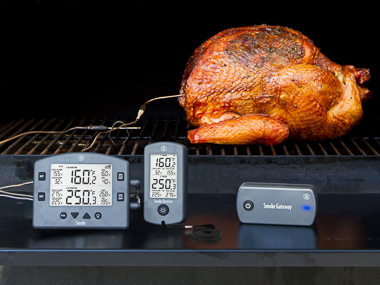
One of the best perks of being a gear reviewer is being able to borrow gadgets and the specialized tools to help test them. I don’t get to keep these things I test, but more often than not, that’s just fine. Last summer, though, I called in a ThermoWorks Smoke thermometer to help me test a grill and it was so useful, I bought it. When a new accessory called the Smoke Gateway—which puts the Smoke’s data to good use—I bought that, too.
Understanding and mastering the control of heat, and being consistent in that mastery are some of the most important tenets of cooking. Used together, the Smoke and Smoke Gateway give you the ability to make hardware like your grill and your oven more accurate, and make you a better, more consistent cook. If mastering heat is a place you want to go, using these tools is like a freshly paved HOV lane to get you there faster.
Jump in the car pool lane and read on in WIRED.
Review: Miracle-Gro AeroGarden Harvest Wi-Fi—An easy-to-use, app-connected hydroponic garden.
WIRED—February 21, 2018
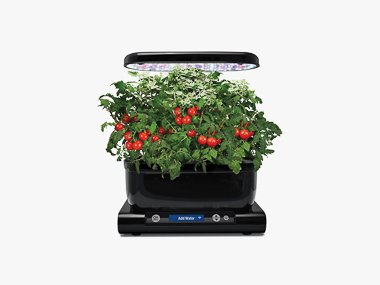
One of the enduring memories my New York years was seeing the blue glow of Times Square from 20 blocks south.
“That’s where the aliens land,” I’d joke. And now, for most of the day, my living room feels nearly that bright.
Under a tiny canopy of red, white, and blue LEDs, six “pods” have gone from plastic dome-covered plugs of peat to a miniature herb garden. It’s a little hydroponic setup that has become a glowing companion in Seattle’s maddeningly wet winter.
A veritable conversation piece, my Miracle-Gro AeroGarden is, in essence, an extremely well-lit plastic tub that now produces dill, mint, parsley, thyme, and two kinds of basil. It connects to the internet, there’s a little built-in control panel, and it uses a mobile app that would feel like overkill except that it’s fairly unobtrusive. During Seattle’s insanely gray January, my herbs got 17 hours of light—an hour more than the Emerald City’s longest summer day—along with a trickle of water pumped to each individual pod for five minutes every hour. The pods cost a couple dollars each, come in sets, and get customized treatment from the machine depending on if they’re flowers, lettuce, or herbs.
Are you ready for Times Square in your kitchen? Read on and find out in WIRED.
Mixtin Review: A New Spin On The Mixing Vessel Tries To Rewrite The Recipe For Stirred Cocktails
WIRED—February 2, 2018

At a good bar, stirring happens inside lovely vessels called mixing glasses, but Cocktail Kingdom’s new Mixtin “mixing tin” promises better consistency through temperature control, swapping out thick glass for vacuum-insulated double walls made of stainless steel.
To figure out if you really need something like this for your bar, read on in WIRED.
Made In Cookware Pan Set—Welcome To The Problem Dome
WIRED—January 25, 2018
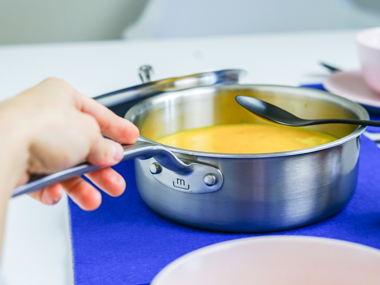
My sister Gina is a fantastic cook who does not suffer crappy cookware gladly. Her pans are battle-tested All Clads that have been roughed up over the years, but they take the abuse she dishes out with a shrug. Once, though, I noticed damage to a T-Fal pan of hers that wasn’t up to the task; the bottom of the pan had a bit of a dome shape to it, meaning hot oil within the pan pooled around the outer rim but did not cover the higher center. Because of this, the food in the middle of the pan cooked at one temperature while food in the oil around the edge cooked at another. I like to imagine her discovering the fault with that pan and sending it flying out her back door and into the yard, where it would be put to use in the sand box.
The pans from a new company called Made In promise US-made, premium-quality cookware. The website claims that its direct-to-consumer sales model allows it to offer steep discounts for that quality, citing an example of a $69 pan from Made In which would cost $150 at a typical retailer.
It’s a hefty claim. You can buy a 10-inch All Clad fry pan for $150, but at this point you might guess why I started this story by mentioning that doming (aka “concavity”) issue. It was a problem I thought I was picking up on when I first started using the Made In pans. I needed to verify whether these pans were domed, and if so, how badly. It was a problem to attack with a feeler gauge.
See if it feels right to you, and read the story here in WIRED.
The Tasty One Top—Tons Of Potential, But Teetering On The Edge
WIRED—January 18, 2018

My test kitchen tends to be a pretty happy place to work. Case in point? I got to make fried chicken the other day. For it, I put the bird parts in a salty buttermilk bath for the afternoon, then cooked them using the brand new One Top from Tasty. I’d tell you more about that first batch of chicken, but in the frenzy, my notes were obliterated by hot sauce and the grease on my fingers.
The One Top is an induction burner—one of a class of kitchen devices that heats a pan not with a flame or other heating element, but by generating a magnetic field. As smart induction burners like the Hestan Cue and the Breville/PolyScience Control Freak demonstrated, this is a category with exciting potential.
Find out if The One Top was up to the challenge here in WIRED.
Like To Party In The Danger Zone? Make Dinner In The Mellow
Wired—January 4, 2018

About two months ago, on a solo afternoon where I didn’t feel like being alone, I lured my buddy Ted over for dinner with some lovely, high-end pork chops. Ted loves a good meal and is Homer Simpson-esqe in his appreciation of well-prepared meat.
I was testing a new $399 sous vide machine called the Mellow, a sort of space-age aquarium with sharp lines, app control, and the ability to both keep food cold then cook it, all in the same tub of water—a modern spin on the set-it-and-forget-it slow cooker. I dropped the bagged chops in the water bath in the afternoon, and the Mellow cooled them until it was time for the cooking to begin two hours later. At that point, it heated the sous vide bath and had them ready for a quick sear right at dinner time. Ted didn’t disappoint either, tearing into the perfect medium-rare chops with zeal.
Among the “busy people” throughlines of Mellow’s homepage video, one of the stories shows a dad hopeless enough to be feeding his grade-schooler some sort of microwave meal, selling it with that “lips-kissing-fingertips” gesture, before graduating to a Mellow-made dinner for the smiling tyke.
The pork chops were my second success of the day. At lunchtime, I had used the Mellow with equally stellar results, making some cod that I cooked in the bag with a white miso marinade. Served with some rocket and a smashed roast potato, it was a luxurious lunch.
Following those meals, I looked back at the time-temperature chart that the Mellow’s app creates and saves for each meal, and was surprised how gradually the temperature dropped in the cooling stage. The cod was only in the water for 41 minutes before it started heating up, but the chops were in there much longer. Though the charts for each had low resolution, the machine seemed surprisingly confident lounging around in what the USDA calls the “danger zone”—the temperatures between 40 and 140 degrees Fahrenheit where the warmth encourages bacterial growth in foods like fish, meat, and poultry.
Anybody who’s ever earned a food-handler’s permit is familiar with the danger zone. The idea is to keep food out of the zone, but if you do need to pass through it, do it quickly, keeping harmful bacteria and the toxins some of them produce at bay. To keep it simple, the USDA advises home cooks to never leave food out of refrigeration for more than two hours.
There’s plenty of reason for caution; bacteria like Salmonella, E. coli, Campylobacter, Bacillus cereus, and Clostridium botulinum love to party in the danger zone.
Learn how the party in the danger zone went. Read the full story here in WIRED.
Essay: Meal Kits Have a Packaging Problem
WIRED—December 28, 2017
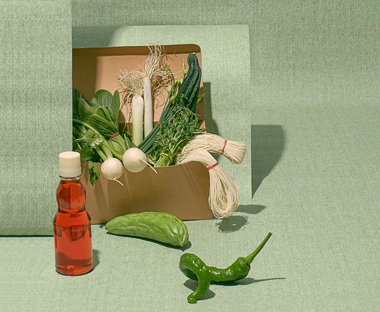
Recently, someone asked me if I thought people were cooking at home less frequently than they used to. I bristled at the query, probably because I was worried that it might be true. Wasn’t everyone out there watching cooking shows then turning off the TV, getting out their mason jars, and whipping up Alton Brown’s watermelon rind pickles?
Anyone fretting over America’s culinary decline can attempt to find solace in the burgeoning popularity of meal kits, those boxes that arrive on your doorstep filled with every ingredient you need for (typically) three meals for two. Just unpack, follow the cooking instructions, and you’ve got a fresh, healthy repast, no grocery store trip necessary. Less than a year ago, meal kits had cultlike cachet. The startups offering these dinners-in-a-box sported aspirational names often involving the word “chefâ€; other monikers sounded like rejected Lucky Charms marshmallows. Blue Apron’s IPO this summer, along with Amazon’s entry into the field and its purchase of Whole Foods, show that meal kits are likely headed for the mainstream. The allure is understandable. I tested four services and found that almost every meal was a hit, and I was cooking dishes—curries, soups, a maple-glazed tempeh—that I almost otherwise never made at home.
But there is a problem: While meal kits may be convenient, their near-brazen anti-Âenvironmentalism should make your stomach ache. Inside the cardboard box you’ll typically find insulation, goopy ice packs, and a bunch of tiny plastic bags and boxes and jars for, say, four sprigs of parsley, a tablespoon of vegan butter, and a shot of mirin. While many purveyors use some Earth-friendly packaging, and Blue Apron will provide shipping labels for sending back certain items, all that stuff had to be produced in the first place. To be sure, as long as you eat all the vittles, food waste—estimated by the USDA to be in the tens of millions of tons each year—is practically nil. But the rise of meal kit services leaves us with a dilemma, weighing personal convenience against adding to already overflowing landfills.
Do meal kits make landfills overfloweth? Read on and find out in WIRED.
The Season’s Best Cookbooks: 6 Picks for Your WIRED Kitchen
WIRED—December 17, 2017

The cookbooks that resonate this year are the ones that get real. Whether encouraging you to use some kitchen smarts, or employing a brute-force meat-shredding method that relies on a sledgehammer, this season’s best cookbooks emphasize technique, authenticity, and the occasional bit of salty language. The fancy kitchen cookbooks are still out there but somehow feel less important, ceding their slots in our rankings to the tomes that focus on making better food at home, perhaps perfecting a long braise or getting a little philosophical instead of fussing with plating.
Find out what made the cut and see if you develop a taste for Kate Lebo’s recipe for Motherfucking Strawberry Rhubarb Pie by reading the story on WIRED.
Modernist Bread Slices Into the Science of the Loaf
Wired—November 7, 2017

Not long after I finished college, I scored my first higher-end cooking job as an expediter and grill guy at a pan-Asian restaurant in San Francisco. It was the first place where I realized I was cooking food that I knew nothing about. Eventually, during my breaks and time off, I’d read books the chef handed to me, to help understand the method and history behind what I was doing.
Later, I came to love The Best Recipe by the editors of Cook’s Illustrated, where their scientific-method style, testing recipes over and over to find the “best” one, appealed to me. I wasn’t a science whiz, but if a team of chefs said it was the best way to do it, I’d do it that way until I had the confidence to do otherwise.
Read through some of the recipes, chapters, and volumes of Modernist Bread, the massive new tome from Nathan Myhrvold and Francisco Migoya, and you’ll realize that there’s a clear line, stretched across nearly two decades, between Best Recipe’s style and Modernist’s.
Out this week, Modernist Bread is the five-volume follow up to Myhrvold’s five-volume Modernist Cuisine. This new collection lays out in encyclopedic fashion what, in the authors’ minds, is the best way to make everything from white sandwich bread to pretzels to vollkornbrot. It is the deepest of deep dives.
Dive in and read the whole story on WIRED.
The December Dripper - Pour Over Coffee With A Twist
Wired—October 28, 2017
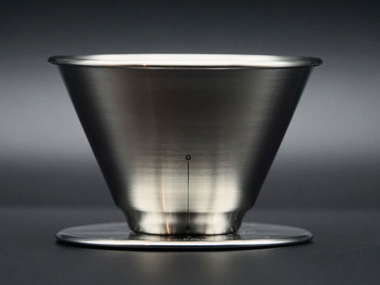
Up to now, pour over coffee brewers were at the mercy of the dripper design, particularly the size of the holes at its base which govern the flow of liquid through the dripper, and thus, how much time the grounds are exposed to the hot water. It’s an important variable: too much contact produces flavors you don’t want from overextraction. Too little contact and not only do you have weak, thin-flavored coffee, but you’re also wasting beans.
Enter the December Dripper ($60), which, by increasing the number of moving parts in a typical dripper from zero to one, allows you to control the flow instead of forcing you go to with it.
Get the full story here in WIRED.
Review: Breville Precision Brewer
Wired—October 18, 2017

AS I PULLED my newest coffee fetish item out of the box, the side view so clearly reminded me of the Avengers Tower that it inspired a few lines of superhero fan fiction:
THE HULK (sipping coffee from a tiny cup, pinky raised): Hey Cap, the coffee tastes different this morning. Do you think the grind is right?
CAPTAIN AMERICA: Dunno, big guy—maybe the water temp is a bit low. Shall we make Tony brew another pot?
(Superhero titters.)
For most of us, making coffee is a near-brainless action. The ease of the process is an advantage when you’ve still got the morning sleepies. Put the grounds into Mr. Coffee’s basket, pour in the water, and press start.
Yet for those who want to explore, there are a near-infinite amount of variables that go into brewing: the brew method, the amount of coffee, the length of the brew cycle, water quality.
Get the full story here in WIRED.
Knead To Know: The Secrets of Gluten, Revealed
WIRED—October 14, 2017

IF YOUR HOMEMADE country loaf comes out of the oven shrunken and dense, you may have neglected a central tenet of breadmaking: Hydrate the flour. When you knead the dough, you are massaging moisture into the wheat’s proteins, creating a matrix of gluten that traps gases so the bread can inflate from the inside. “The gluten structure is stretchy but impermeable,†says Nathan Myhrvold, the tech millionaire, chef, and creator of 2011’s six-volume science-of-cooking megawork, Modernist Cuisine. Now, Myhrvold and his team of food scientists and photographers are back with five more volumes, focused exclusively on bread.
The photos in the $625 labor of loaves, ÂModernist Bread, range from cross-sections of rising sourdough to artful, side-lit layers of injera. But so much about baking, as any practitioner worth their pinch of salt will tell you, takes place at the invisible-to-the-eye chemical level, and Myhrvold wanted to expose that hidden process.
For the image above, his crew rinsed a small ball of dough with water to wash away starch granules and water-soluble proteins, leaving behind a blob of near-pure gluten. Then, using a scanning electron microscope borrowed from Myhrvold’s company, Intellectual Ventures, they captured a slice of the gluten magnified to 734X, tweaking the contrast of the black-and-white image to give maximum visibility to the webby network at the heart of every perfectly quenched, ready-to-bake gob of pre-bread. As Myhrvold puts it, “That web makes wheat breads what they are.†Meaning: chewy, delicious, and upsetting to gluten-sensitive stomachs everywhere.
Read the story here in WIRED.
PHOTO: The Cooking Lab, LLC.
Review: The Traeger Timberline 850
Wired—October 7, 2017
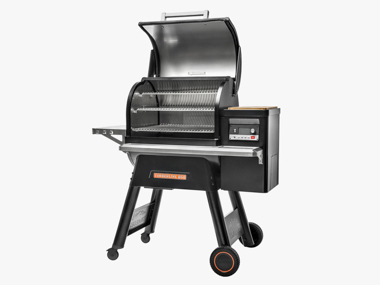
ON A RECENT trip to my parents’ place in New Hampshire, I cooked up some chicken leg quarters on the Traeger Timberline 850 grill that I’d brought along to review. I set it to the exact temperature the manufacturer suggested, lit the grill with the press of a button, and, using an app, remotely monitored both the temperature inside of the grill and the internal temperature of the legs and thighs as they cooked.
When the chicken reached 165 degrees Fahrenheit, I opened the grill, expecting smoke-tinged chicken perfection. Instead, I called mom for help.
The internal temperature indeed read a perfect 165, but the skin was rubbery and there was no way I was going to get the heat jacked up to searing temperature without severely delaying dinner and potentially overcooking the food. Instead, my mom browned the skin in a skillet on the stove, saving dinner. The chicken turned out so fantastic that I wondered if the manufacturer’s product and recipe testers instinctively counted on us to ask the lady who brought us into the world to come to the rescue.
Read the complete review here in WIRED.
Review: Dave Arnold’s Spinzall Culinary Centrifuge
Wired—September 15, 2017
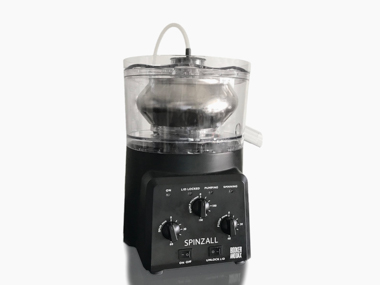
NOT LONG AGO, I poured a bottle of fancy whipping cream into the gadget I was reviewing, started it up and watched in awe as the machine’s rotor began spinning rapidly, creating a vertical wall of solidified dairy that stayed in place after the machine wound down.
“Behold,†I exclaimed as my wife Elisabeth passed through the kitchen. “I made butter in a centrifuge!â€
“Wow,†she said with a tone that foretold bubble bursting. “Did they run out of butter at the store?â€
The centrifuge, called the Spinzall, was created by culinary wizard and bartender extraordinaire Dave Arnold, the same man who brought the Searzall to life. Dave’s newest contraption is an $800 hulking black appliance that, with a pair of tubes jutting up out of the back, looks like the progeny of a top-of-the-line food processor crossed with a beer hat.
Clearly Elisabeth was just missing the machine’s potential. Along with butter, centrifuges can be used to clarify juices, create transparent herb oils, and make nut milks and even ultra-smooth baby foods.
I spun it up again, this time to whir up bartender Jamie Boudreau’s recipe for clarified Clamato juice, then combined it with a Pacifico and lime juice to make an elegant, clarified michlelada.
“Mmm,†said Elisabeth, “almost as good as the one we had in Guadalajara.â€
Was she doing this on purpose?
“You were upstairs for a couple hours. Was all that time just to make the one ingredient?â€
I pretended not to hear her and, undeterred, I went to the store and bought 40 limes.
Read the full review here on WIRED.
Wheat Nerds and Scientists Join Forces To Build A Better Bread
Wired—August 4, 2017
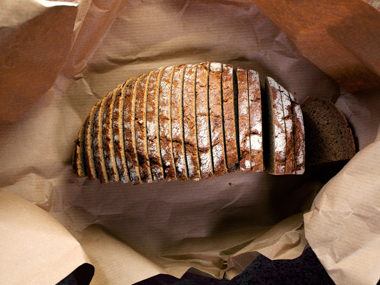
A FEW DAYS ago, in the middle of a field, Dawn Woodward and Jeff Yankellow presented me with a whole-wheat croissant, the thought of which would normally make me wretch. That pastry carried a pedigree, though. I was in Washington’s fertile Skagit Valley at the Grain Gathering, a conclave of 250 of the best bakers, millers, grain scientists, and industry types from the United States, Canada, and five other countries. Woodward, a baker at Evelyn’s Crackers bakery, and Yankellow, of King Arthur Flour, would have been fools to try to pull a fast one on this crowd.
As someone who’s lived in France for 10 years and written about food for 15—and is cognizant of the bile likely to appear in the comment section at the bottom of this page—I will say this anyway: This pastry stood shoulder-to-shoulder with top-flight Parisian croissants.
Like me, legions of people are averse to whole-grain anything. Experts attending the Grain Gathering and their acolytes share that opinion, but they strive to make such foods so delicious that you might need to reconsider. Backing it up with a ton of lab and kitchen legwork, and taking into account the viability of everyone who deals with the grains, from the field to your table, the best minds in the whole grain field want to sell the masses on flavor.
Read the whole story here in WIRED.
Review: Breville’s Oracle Touch: Pro-Quality Espresso At Home, For The Price Of A Used Car
Wired—July 28, 2017

FOR A FEW months in the late 2000s, I lived in Palermo where I was transfixed by a barista’s skills on a near-daily basis. This was a white shirt, black vest lifer, an artisan who could run his machine blindfolded. Every gesture and all of their effects were thought out and internalized long ago. Customers waited their turns patiently because he was the best.
At home, we’d all love to be Mr. Palermo, but typically, our rinky-dink countertop machines lack the power and we lack the skill to make the perfect cup; it’s not just for convenience that we give the person behind the counter at our favorite café four bucks for a latte.
If home machines which require nothing from you but pushing a button to select a drink are your thing, brands like Jura (perhaps recognizable for those goofy ads with Roger Federer) and Saeco do a respectable job of getting you going in the morning. You’ll pay handsomely for it, though, from hundreds to thousands of dollars.
While this fully-automated coffee is consistent, it’s not everybody’s bag. Many of us want to be more hands on, but lack the skill to do all the little things you need to do every time to consistently make an excellent cup.
Breville’s Oracle Touch is astounding in its all-in-one-ness, offering several espresso-based drinks and custom creations on its home screen. (Yep. It’s a coffee maker with a touch screen.) It stores beans, grinds them, dispenses the grounds into a portafilter—the handle with a cup that holds the puck of grounds—tamps and pre-infuses them, then pulls a shot. With dedicated steam and espresso boilers, it can foam milk to your choice among a range of consistencies while the shot is pouring.
The Oracle cleverly straddles a line, offering an impressive amount of customization and hands-on time, while automating enough that you’d have to try hard to make a bad drink. I’ve paid nearly as much for cars, but for those who are able to plunk down $2,500 on an espresso maker, Breville has created an outstanding machine.
Read the full review here in WIRED.
Review: Meal Kits Provide Tasty Dinners, With A Side Of Landfill
Wired—July 19, 2017
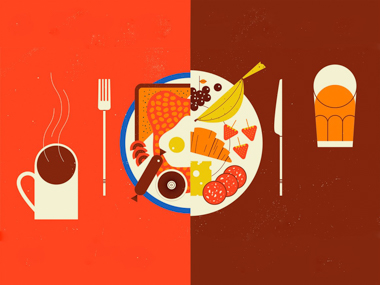
MY WIFE ELISABETH wandered into the kitchen while I was testing a Blue Apron meal kit. She lifted one of the 4-pound Nordic ice bags that came in the box and gave the thawed, semi-glutinous thing a squeeze.
“You could make a breast larger with this stuff,” she declared before investigating the bubble-wrapped foam lining inside the cardboard wall of the box. “It’s like a disposable cooler!”
Her reactions were more investigative fascination than judgment, but I couldn’t help but wonder if this was part of the reason—along with Amazon’s purchase of Whole Foods—for Blue Apron’s disappointing recent IPO and subsequent stock market slide.
My initial goal was to review the efforts of several individual companies that provide ready-to-cook meal kits. But after testing multiple meals delivered from Blue Apron, Purple Carrot, Home Chef, and the new offering Amazon Fresh has begun to roll out, Amazon Meal Kits, I found that they were all similar enough that I wanted to take an updated look at the meal kit concept.
Read more here in WIRED.
Review: Cook By Numbers With The Hestan Cue
WIRED—July 13, 2017

IN THE KITCHEN, people have an amazing tolerance for imprecision. Ovens might say 400 degrees, but many regularly veer 20 degrees above or below that mark, if it’s calibrated correctly in the first place. On the stovetop, we don’t even have the specificity of degrees. Turn the dial up to “high†or “medium-low†or just “seven,†even though every manufacturer has a different standard for what that place on the dial means.
In the past several years, a string of mostly smaller companies have made a push toward real numbers. Sous vide machines cook food in a water bath held at a steady, exact temperature. Precision countertop ovens with less temperature range are hitting the market. The Breville PolyScience ControlFreak is an induction burner that uses both a nub with a thermometer to measure the heat of the bottom of a pan and a probe that reaches into the pan to take the temperature inside. It can control the intensity of the power that goes into getting it up to speed, then turn on cruise control so the temperature stays right where you want it.
Cookware manufacturer Hestan has a new take on this with the home-chef friendly Cue, a 1600-watt induction burner that looks like a miniaturized Roomba. A custom 11-inch fry pan with temperature sensors in the base and a tiny circuit board in the handle sits on top. The fry pan and burner are sold together for pause-inducing $500.
Read my WIRED review here and find out if the Cue’s kind of connected cooking is worth it.
Review: Stasher and Anova Team Up On Multi-Use Sous Vide Bags
WIRED—June 28, 2017
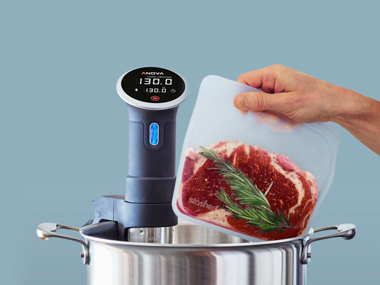
I DON’T HAVE many pet peeves in the kitchen but washing plastic storage bags might just top that tiny list. As the guy who started his high school’s recycling program, I just can’t bring myself to throw them away, but damn, those bags are no fun to clean. Take your pick: washing them in the sink leaves the back of your had covered in cooking juices and oil while sticking them in the dishwasher turns them into crumpled bags with pools of cloudy water. Yuck.
Sous vide cooking, where food is sealed in a plastic bag and cooked in a water bath held at a specific temperature, goes through a lot of bags. I love the technique—you can cook salmon medium rare, steaks just the way you want, and chicken breasts in a near miraculous way—but the bags pile up in a disconcerting fashion.
Plastic bags were part of a conversation I had a few years ago with a friend in the sous vide industry.
“There are a lot of smart people working hard on that very problem,†the friend told me. Then, for a good, long while, nothing happened.
At the time of the conversation, most home-cooked sous vide happened in thicker bags, known simply as sous vide bags, that were sucked shut with a vacuum sealer. Eventually, there were glimmers of hope. A company called Oliso came out with bags that could be reused several times with its proprietary vacuum sealer, which was a promising idea but a mess to work with. Later, people started accepting the idea that you could cook in a Ziploc-style bag, which work up to about 160 degrees Fahrenheit (70 degrees Celsius), but any higher and you’re courting disaster in the form of a burst seam. You could also ditch the vacuum sealer and use the pressure of the water bath to displace the air out of the submerged bag, which was one less barrier to a new way for people to cook at home. Still, those bags going into the trash bugged me.
Now, however, the $12 Stasher, a beefier bag made of silicone, which looks like a sandwich bag for scuba divers, might change the market. The bags are durable enough to sustain thousands of uses if you’re careful with them and—hallelujah!—they’re dishwasher safe.
Read the whole WIRED review here.
Review: Oh, Look, A $350 Box To Hold Your Cheese
WIRED—June 9, 2017
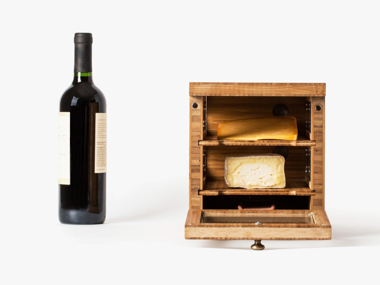
WALK UP TO the cheese counter at DeLaurenti Food & Wine in Seattle and you’ll find offerings from the worldwide luminaries of cheese: l’Amuse from Holland, Guffanti from Italy, Neal’s Yard Dairy from the United Kingdom, and Hervé Mons from France, all there in cold cases, like jewels in a museum. It’s awe-inspiring. Leave the store with a few of those beauties, which average more than $30 a pound, and you’ll want to cosset them until it’s time for the cheese course, then display them like works of art.
I arrived at the store with a glass and bamboo box designed to extend the life of these fine cheeses by creating the perfect storage conditions. Riding the train, I could feel people glancing at it, perhaps wondering if I was carrying a hamster. In DeLaurenti’s, however, the box was received like the cheese world’s equivalent of an unreleased iPhone.
This box, called Cheese Grotto is the brainchild of Brooklyn cheesemonger Jessica Sennett, who calls it a “humidor for cheese.†Barely bigger than a breadbox, it features two shelves to store and display cheese, a terra cotta brick you can soak with water to maintain the humidity for up to a week, a tiny vaulted ceiling to keep condensation from dripping onto the cheese, and a sliding back wall to control airflow. With a $350 price tag, think of it as a luxury apartment for dairy.
At that price, is it worth the rent? Read the complete WIRED review here.
Holy Shucking Fit! You Might Be Shucking Oysters All Wrong
WIRED—March 16, 2017
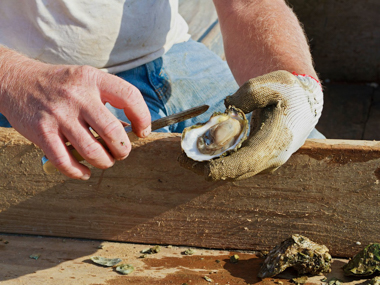
NOT QUITE A year ago, I wrote a story about the merits of good oyster knives, getting a shucking lesson from a pro in the process. I walked away from the lesson with a refreshed appreciation for finding the right tool for the job, but what was most impressive was the shucker’s technique, which was like nothing I’d ever seen.
My lesson came from Lucas Stone, a shucker at Seattle’s fantastic Westward restaurant, and he demonstrated a subtle technique with the formal beauty that recalled the tango. Choking up on the knife with one hand and palming the oyster in the other, he snugged the tip of the blade into the oyster hinge, then raised them together to his chest, and popped it open, almost imperceptibly.
I returned to Westward recently, to get the skinny on the technique, this time meeting with Ted Stearns, winner of the shucking competition at the 2015 Bearfoot Bistro World Oyster Invitational & Bloody Caesar Battle in Whistler, British Columbia. Stearns, 29, has a callus on his right hand that’s pronounced enough to notice when you shake it, a bump that’s the result of spending years working with an oyster knife.
At the competition, sterns shucked 30 oysters—10 Virginicas, 10 Pacifics, and 10 tiny Olympias—in 3 minutes and 11 seconds.
“I won because I was shucking by hand, not table shucking,” he says, breaking shucker-dom down into two techniques. Table shuckers are the far more common breed, particularly at home, working on a countertop. While hand shuckers can work their way in from the bill (the larger, rounded end of the shell), Stearns prefers starting at the hinge, aka “buttshucking.”
There’s only one way to find out if you’re a buttshucker—read the full story here on WIRED.
A Review: Panasonic’s Countertop Induction Oven—Underdone
Wired—February 15, 2017
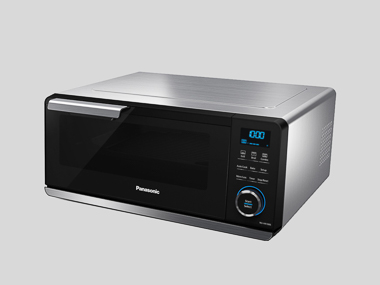
Panasonic gave a splashy introduction to its Countertop Induction Oven at this year’s CES, promising to get tasty dinners on the table in record time by blasting them with impressive-sounding technology.
This oven, aka the CIO, pairs an induction burner—which uses an electromagnet to heat a pan on the oven floor—with more traditional infrared burners up top. At $600, the CIO is very pricey, but I’ve got a soft spot for induction burners, usually in the form of a stovetop or standalone plug-in burner, and the whole idea sounded like it had potential.
Perhaps I should have stopped there…Read the full review in Wired.
Review: PicoBrew Pico—Drinking Game
Wired—December 6, 2016
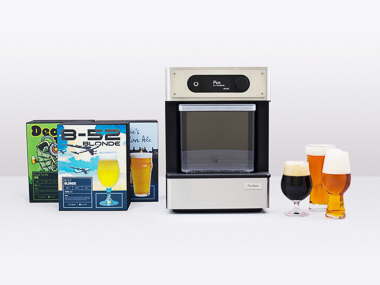
If you’re an avid fan of regional microbreweries, a new home-brewing machine offers an ability that’s like having the ability to tap a keg 3,000 miles away.
It sounds enticing but in terms of use beyond just a couple of batches, is the PicoBrew Pico something that’s going to get a long-term use?
Find out in the full story on WIRED.
Review: Thermomix—Smart Kitchen 101
WIRED—December 12, 2016

THE SMART KITCHEN is the buzzword of the culinary world, connecting appliances to a phone, a tablet, and even the cloud in the name of efficiency. It’s a new market that’s still finding its feet, presenting a mix of industry-changing innovation and utter malarkey.
Memo to today’s smart kitchen pioneers: A team of German engineers has a 40-year jump on you, and they’re already into the fifth generation of an intelligent, powerful, and near-infinitely useful machine.
It’s also unconnected.
Read the story and feel the Thermomix love on WIRED.
Cookbooks With A Dash of Science
WIRED—November 13, 2016

ONE DAY, WE might look back at 2016 and realize it was the year where everybody finally started getting comfortable with the idea of science in the kitchen. From the latest from Cook’s Illustrated and Alton Brown to funky fermentations and delicious dehydrations, here are some of the year’s best books.
Read the story on WIRED.
Inside the Battle to Rule the Smart Kitchen of Tomorrow
WIRED—October 29, 2016
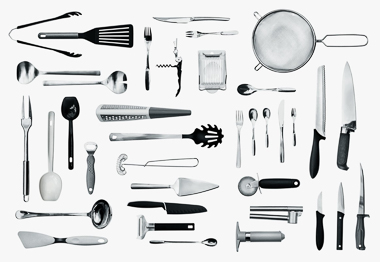
KITCHEN ARCHITECT JOHNNY Grey gives smart, inspired speeches that could be TED Talks. He speaks about the things you’d expect from somebody dedicated to kitchen design, like light, and where you stand to cook. But he also introduces concepts like the physical invitation of a space and the allure of imperfection. A bit loopy, maybe, but he always bases his designs on how people work in and interact with a space, and with each other. The kitchen should be functional, of course, but it should be a social, inviting spot that revolves around people.
We’re in the moment of the connected kitchen, in which kitchen appliances sync to the cloud and even your coffee maker has a companion app. Look at the photos of Grey’s kitchens, however, and you’ll notice none of them feature a screen.
“It’s as if we are in the calm before the storm,†Grey says, “treading in that marshy ground between interesting, potentially useful, and sci-fi.â€
As the smart kitchen is now being pushed into the mass market, it’s a good time to keep Grey’s principles in mind. There are an ever-growing number of smart appliances; some of them are great, but many are just not fully baked.
Do we really need this stuff?
Read the full story in WIRED.
Review: Misen Chef’s Knife
WIRED—October 29, 2016
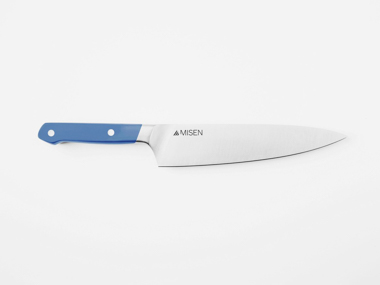
AMONG ALL THE tools and gadgets that can fill a kitchen, knives are without a doubt the most personal and indispensable. Admire one in a chef’s collection and prepare for an unsolicited earful of its history, but do not expect an offer for you to try it. My own collection is modest but I’m proud of it. Among them, my favorites are a Wüsthof Classic Cook’s Knife and my Tadafusa santoku. The Wüsthof capably does everything from mincing a shallot to cutting up a chicken and the sharper blade angle of the santoku cuts through vegetables like a scalpel.
A new chef’s knife from Misen promises the best of both knives, making giant-killer claims about innovative geometry, high-grade steel, a santoku-style blade angle, and free sharpening for life. Most impressively, it brags of what it calls the “honest price†of $65, a number that’s less than half the price of the high-end knives it calls its competition.
Intrigued, I called one in to test. Misen started as a Kickstarter but is shipping its knives this fall. Days later, I had my chef’s knife, my santoku, and the Misen chef’s knife lined up next to one another on my cutting board. The most striking feature of the Misen was the side view, which looked a bit like both knives, combining the flatter belly of the santoku and both the handle and upward sweep at the tip of the chef’s knife, a sort of westernized version of a Japanese knife known as a gyuto.
I bought a bag full of groceries to chop and declared the game afoot. The differences between the three knives were immediately apparent. While the Misen most resembles a traditional chef’s knife, it doesn’t really behave like one. The Wüsthof has a large, curving ‘belly,’ a German style that encourages a rocking cutting motion with the tip of the knife planted on the board, the back end moving up and down, while the whole thing slides back and forth with each stroke. The santoku style relies more on keeping its flatter blade parallel to the cutting board, gliding forward with each downward movement.
For me, the Misen often felt most comfortable using a santoku-style stroke. It was particularly noticeable when I was working my way through something tall like a wedge of cabbage or chopping up a pile of herbs. Try a stroke that allows the Wüsthof to power through that kind of work with the Misen and it’ll feel like a flat thud every time the length of the blade hits the cutting board. That said, I felt confident that the best stroke for whatever I cut with the Misen would become apparent with use, and I’d get better with it over time.
... that’s not the way it worked out. Read the rest of the story here.
Review: Balmuda The Toaster
WIRED—Sunday, October 16, 2016
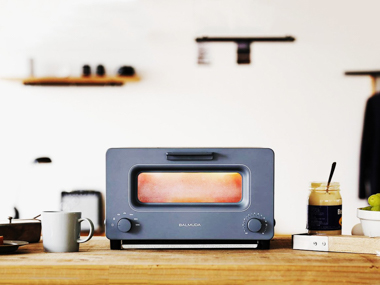
FOR REASONS THAT never became clear to me, my brother-in-law Gregory emailed over the summer suggesting that I review a toaster called the Balmuda available only in Japan and Korea. His subject line was persuasive. It read: “The Perfect Toaster.”
I’d done some research on toasters a year prior and found the industry to be something of a confused sea: neither the brand nor the amount of money—from dirt-cheap to ludicrous—spent on a toaster guaranteed quality. It’s also not a space rife with innovation. The toasters we’re using today and the ones manufactured a generation ago are pretty similar, though the ones we’re using now tend to be chintzier.
Toaster ovens are their own special category separate from traditional slot toasters, and, thanks in large part to the distance between the heat source and the toast itself, they’re not renowned for making great toast. In fact, toaster-oven toast tends to be dried-out toast. This one, dubbed Balmuda The Toaster (about $220), seemed like it should be lumped in the toaster oven category, but Gregory’s subject line nagged at me. I also watched a video where, before toasting, water is poured into a slot into the top of the oven before toasting, effectively converting the Balmuda into a mini steam oven, a hack designed to keep what’s being cooked from drying out.
Getting my hands on one required some effort.
Was it worth it? Hell yes! Read about it here!
Review: Breville Fast Slow Pro—Pressure Drop
Thursday, September 22, 2016
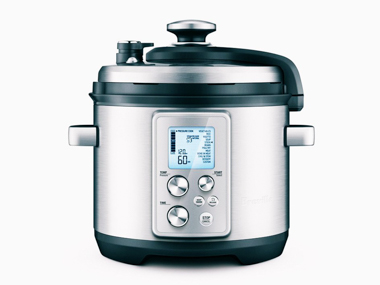
Pressure cookers are heralded as near-magical kitchen appliances, making stocks, cooking grains, creating risottos and other flavor-packed meals in a fraction of the time other methods might take. They are smart timesavers and workhorses with a lineage that extends back to the stovetops of our great grandmothers.
Pressure cookers are also enjoying a mini-renaissance, thanks in part to the availability of models with more and better pressure release valves, which makes them safer than older versions. Particularly popular right now are electric varieties that offer a degree of control harder to achieve in stovetop models.
I’ve been writing about food for close to 20 years. I’ve written the cookbook for a high-end restaurant, tested recipes professionally, worked in about a dozen restaurants and even done some personal chef work. Somehow, in all this time, I had never used a pressure cooker, so I felt a frisson of excitement when the doorbell announced the arrival of Breville’s Fast Slow Pro and, in effect, the imminent expansion of my culinary repertoire.
Thing is, that didn’t happen. Find out what went wrong in the full review on WIRED.
Review: Weber Summit Charcoal Grill—Burn Rate
Sunday, September 11, 2016
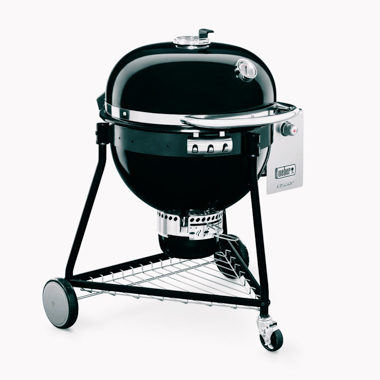
Jeff the Weber Grill rep arrived, huffing and puffing at the top of the steps as he introduced himself. His wife Jill looked on worriedly from the door, beyond which lay their big, white delivery van.
“I don’t think it’ll fit,†Jill said. “That grill’s big.†This was an understatement. Once we hauled it up the stairs and shimmied it through the front door, I had to pop a sliding glass door out of its track to get the grill out to the back deck.
Behold! The Weber Summit Charcoal is a $1,700 behemoth that looks like Weber’s classic kettle grill on steroids. It comes with a circular cooking grate with a monster 452 square inches of grilling space, and is looking to push its way into a category dominated by legions of devoted fans and a mountain of grill lingo.
I’d set up delivery to coincide with a vacation trip to Oregon, stopping at my cousin-in-law’s butcher shop in Portland for a cooler full of good meat. There was a lot to cook.
“If you can catch it, you can cook it in there,†Jeff proclaimed before climbing back into his van. I realized that I could easily cook a party’s worth of food on the Summit.
Could this kamado grill competitor take the heat? Hell yes! Read the full WIRED review here.
Smartphone-Enabled Kitchen Gear Can (Probably?) Make You a Better Chef
Wednesday, July 6, 2016

THE JETSONS KNEW how to cook: Ride the conveyor belt over to the kitchen console, press the Bacon button and—BOOP!—there’s breakfast, rising up out of the kitchen table. The animated 1960s TV series was right about some aspects of the future (video phones, for one thing), but for kitchens, well, we’re not quite there yet.
The idea of the smart—or connected—home, that is linking appliances to the Internet in order to make life better or easier by, say, allowing you to make sure your garage door is shut even if you’re at the office, or keeps your plants watered, is a good first step.
The latest thing on the menu in the connected home kitchen is something called ‘guided cooking.’ No, Gordon Ramsay doesn’t come to your house and yell at you. Guided cooking is where a heat source and a pot (or a sensor in the pot) communicate with each other through an app that walks you through a recipe and keeps everything at the right temperature as you cook your way to dinner. It’s no Jetsons food robot, but it’s got legs.
Read the full story on WIRED to learn if you should be an early adopter.
Go Shuck, Yourself: 4 Oyster Knives Reviewed
Thursday, June 2, 2016
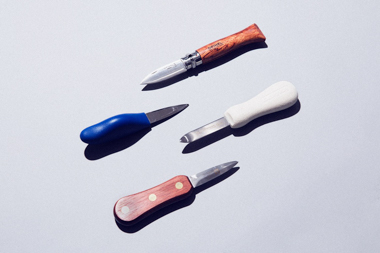
WHEN I WAS a kid, I loved going to work with my dad once or twice a year. Dad was a salesman and on the days we went into Boston for work, he’d bring me to a Faneuil Hall kiosk called The Walrus and The Carpenter for oysters. It had a big, wooden bar with brass foot rails, all crowned by an enormous display of oysters on ice. The whole thing served as an introduction to doing something good for yourself and the pleasures of a good, raw bivalve.
At home, we’d occasionally buy a dozen from Donahue’s Fish Market in Plaistow, New Hampshire, take them home and pry them open with a large, clear-handled Craftsman slot head screwdriver. It was a holy mess cracking those suckers open, but they were damn good.
I grew up to become both a food writer and knife fanatic, but for reasons still unclear to me, I never owned an oyster knife worth a hoot. Until very recently, my only oyster knife was a blue rubber and plexiglass number I picked up in a grocery store. The first time I used it, I knew that it’d eventually snap in half.
Now, at Seattle’s landmark restaurant, Westward, I meet Lucas Stone, one of the shuckers at the in-house oyster bar known as Little Gull and get a lesson in what to look for in a good oyster knife. Stone pulls out a wooden box of bar knives from a low shelf and finds a handful of oyster knives at the bottom. They’re all beefy, purpose-built tools with sturdy blades and ample-sized handles.
“Here’s my favorite,†he says.
Find out what Lucas’ favorite oyster knife is, along with three other great options, in my review for WIRED.
Review: Pat’s Backcountry Beverages—Brewskis In The Bush
Thursday, May 5, 2016
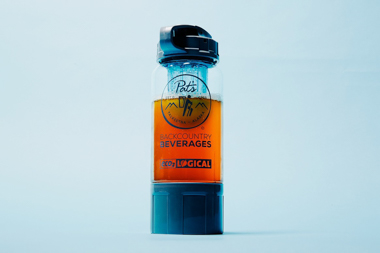
HIKE TO THE top of your favorite mountain, kick back, put up your feet and you may find yourself thinking that the only possible way to make it better would be with a tall, cold one. That’s a dream for many hardcore hikers, and the tale spun by Patrick Tatera, founder of Pat’s Backcountry Beverages in Alaska. Tatera thought long and hard about how to make it work.
That meant he’d need a way to carbonate mountain stream water, and combine that with a syrupy sort of “brew concentrate.†There are so many variables at play that can make a huge difference with carbonation in general—the temperature of the liquid and the amount of sugar in it, for example—that it’s amazing his creation works at all, even if the results are mixed.
Will it make the best beer you’ve ever had? Maybe not. Will you care after a long hike? Nope! Read the full review on WIRED.
Review: T-Fal OptiGrill Plus—Controlled Burn
Tuesday, May 3, 2016

A few nights back, my wife and I had some friends over for a barbecue on our apartment roof. When it came time to start the festivities, I immediately lit the grill on fire, and not in a good way. I needed to cook off many months-worth of caked-on grease and crap stuck to the grate and interior of our “community grill.†So, I shut off the gas line and let it burn.
Meantime, I fired up the electric T-fal OptiGrill Plus on the table next to the grill and threw on a ribeye to keep our guests happy. The OptiGrill—no relation to Steve Martin’s Opti-Grab—is like former boxer George Foreman’s Lean Mean Fat-Reducing Grilling Machine for a semi-digital age. Turn it on, poke a button on the handle that corresponds to the the kind of protein you’re cooking and, T-fal says, it will cook your food to the exact amount of doneness you want. Closing the grill (it’s panini-style, so it cooks from the top and bottom simultaneously) tells it the thickness of what you’re cooking and allows the machine to adjust time and temperature accordingly.
Sounds promising! Was it the best cooking experience I ever had? It was not. Not even close. Read the whole story on WIRED and learn how it all went wrong.
Review: Breville PolyScience Control Freak—Burnin’ for You
Friday, April 1, 2016
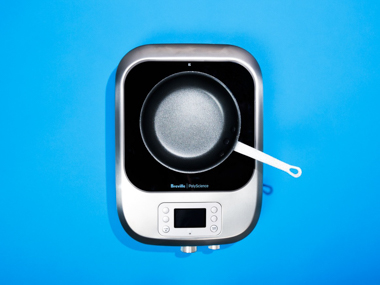
Almost every day in my well-used home kitchen, I work with a double standard. I pop something in the oven and dial in a specific temperature, say 175°C. However, on the stovetop, I settle for the vagueness of low, medium, or high. When I go see my mother-in-law, and swap my electric range for her gas flames, is my “medium†the same as her medium? No, it is not.
Set for release today, Breville/PolyScience’s Control °Freak is a restaurant-grade induction burner that allows a chef to dial in either the surface temperature of a pot or the temperature of the liquid inside it. As someone with the disposition to experiment with the options this presents, this gave me a little frisson, accompanied by the feeling I was seeing the future.
Did I see the future? I think I did. Read the full review on WIRED.
Hacking Your SodaStream With a Paintball Canister Can Save You Piles of Money
Friday, March 4, 2016
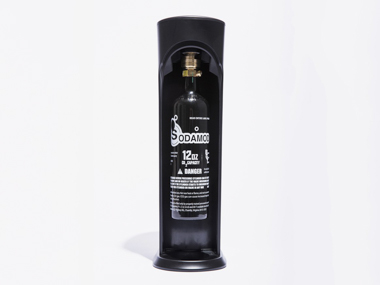
We drink a lot of carbonated water in my household. Enough, in fact, that we’ve owned a trusty SodaStream Fountain Jet (the company’s entry-level carbonator) for years. Even with the sunk costs of the machine itself and the purchase of a pair of tanks, we know it paid for itself long ago.
The per-bottle cost is roughly 25 cents per liter of carbonated water. It’s much cheaper than supermarket seltzer, and it involves less worry about the environmental costs of making plastic and glass bottles and shipping them around the world. I like that.
When I refill my two new tanks, it costs $10 instead of $45, and I’ve got some nice, cheap fizz on tap. The thing I don’t like is that the small SodaStream tank refills cost about $15, each one making roughly 60 liters of carbonated water. Technically, you’re really paying for 410 grams of CO2, part of the very air you’ve been breathing for free all of your life.
Could I find a better way? Find out in my story in WIRED.
Soft, Airy Chinese Steamed Buns: Simplified
ChefSteps - March 2016

The Chinese steamed buns known as bao have been around for more than 1,500 years, but it took chef David Chang to turn them into a global phenomenon. He did it by centering dishes around them in his Momofuku restaurants, where every meal is an event.
We’ve thought long and hard about how to turn these into something easy to make at home.
Get the story and make the recipe here. (Registration required/paywall)
I co-wrote the headnote [introduction] and tested the recipe for this project.
(Photo: ChefSteps)
Review: DrinkMate Carbonator—Under Pressure
WIRED - Gadget Lab - Friday, February 12, 2016

Early last year, an editor asked me to review and rank home carbonators—those countertop machines that turn chilly water into lovely seltzer. Research quickly revealed an industry in chaos. Some brands were plagued with deservedly horrible reviews or simply didn’t sell. One, with a tendency to explode, was recalled. SodaStream made carbonators that some people liked and had politics that some didn’t. It got so complex, I needed a spreadsheet to keep track of it all.
Now, however, there’s a carbonator that allows you to do what SodaStream couldn’t—carbonate more than just water. Read the complete WIRED review here.
(Photo Josh Valcarcel/Wired)
Recipe: Ultimate Chocolate Cake
ChefSteps - February 2016

Use a mix of classic techniques and—of course—a ChefSteps twist to create a showstopping, multi-layer cake with an incredibly deep chocolate flavor.
Get the story and make the recipe here.
I tested the recipe for this project.
(Photo: ChefSteps)
Review: Rabbit Freezable Beer and Whiskey Glasses—A Chilly Reception
WIRED - Gadget Lab - Thursday, January 21, 2016
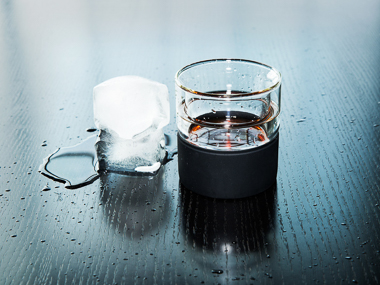
Flipping toward the crossword in the Sunday paper not long before Christmas, an ad for some puzzling-looking glasses caught my eye. Rabbit, manufacturers of a well-known corkscrew, had introduced freezable beer and whiskey glasses designed to cool your drink and/or keep it chilly. Existing technology—refrigerators for beer, ice cubes for whiskey—already do this, and a question leapt to mind: What problem do these glasses solve? As far as I can tell, the answer is “none.â€
Read the complete WIRED review here.
(Photo Josh Valcarcel/Wired)
Amazing Chewy Bagels From Scratch
ChefSteps - January 2016

With a hands-off approach that encourages the full, complex flavors that only time and fermenting yeast can provide, this recipe will fill your house with the amazing aroma of bagels and your mouth with their chewy texture, and soft, springy interiors.
Get the story and make the recipe here. (Registration required)
I wrote the headnote [introduction] and tested the recipe for this project.
(Photo: ChefSteps)
8 Food-Prep Apps That’ll Make You a Ninja in the Kitchen
WIRED - Gadget Lab - Sunday, December 13, 2015

From recipe help and sustainable seafood to the perfect pour and eggs just the way you like ‘em, these eight apps give you stellar advice at home, and help you make tastier choices when you’re out shopping.
Read the full WIRED reviews here.
Review: Drop Kitchen Scale—Connected Kitchen Scale Shows Cooks The Weigh Ahead
WIRED - Gadget Lab - Saturday, November 14, 2015

One of the best restaurant tools has been slow to catch on in home kitchens: the humble scale. Americans’ reluctance to use weight to measure ingredients has a lot to do with our recipes being written in a volume-centric style. Weight measure is more accurate—dry ingredients can compress when you scoop them, introducing variations in volume—but we still stick with our cups. The Drop scale and its attendant app could get you to change your ways.
Read the complete WIRED review here.
[Art: Josh Mckendry/Wired]
The 5 Pizza-Making Tools You Need to Create a Perfect Pie
WIRED - Gadget Lab - Saturday, November 12, 2015

Making pizza at home should be an event. From a hot steel for your oven to a sharp wheel to cut that pie, these tools make it happen.
Read the full WIRED reviews here.
[Art by Joe Mckendry/WIRED]
Review: Sansaire Searing Kit—Cooking With Fire
WIRED - Gadget Lab - Tuesday, October 27, 2015

Cook one of the best hunks of meat of your life and moments before it goes out to the table, it will almost certainly look like a great, gray blob. Get a nice sear on it, though, and suddenly you’re talking turkey. Or honey-browned ham. Or perfectly pink standing rib roast.
But back to that blob, which you’d first cook sous vide (the technique where protein is sealed inside an airtight plastic bag and cooked in a water bath held at a precise temperature, say 135°F / 57°C for a medium-rare steak). After you get that to sear, you’ve got two good options: The first is to get a skillet screaming hot and throw your protein right on there. It’s an imperfect solution as that ham might be fall-apart tender and hard to manipulate. Plus, there will be difficult-to-reach crevices that aren’t even touching the heat.
Option two is much more fun: Hit it with a blowtorch.
Read the complete WIRED review here.
(Photo Christie Hemm Klok/Wired)
The Rise of the Blue-Footed Chicken, the Best Damn Bird You’ll Ever Eat
Seattle Weekly - Tuesday, June 16, 2015

In the world of chicken breeding, one bird represents the Holy Grail. Tall, noble and blue of foot, the name-protected poulet de Bresse can command prices well upward of 50 euros ($70) per bird in a Parisian market.
The famed French chicken is miles better than the Cornish cross – North America’s hormone-filled, mass-produced supermarket bird – but virtually none of the Bresse birds make it out of France.
Undaunted, British Columbian breeder Peter Thiessen — known to many as a tough bird himself — figured out how to breed a chicken that looked like a poulet de Bresse and, by some accounts, tasted better. It took him 11 years.
And that’s when things went squirrelly…
Read the Seattle Weekly cover story here.
Review: Codlo Sous-Vide, A Chilly Reception
WIRED - Gadget Lab - Wednesday, April 15, 2015
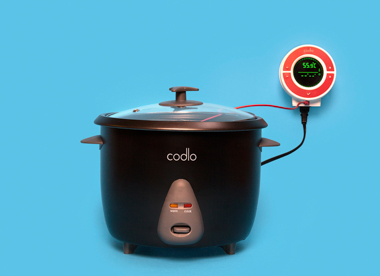
It’s hard to rate a product that feels like it should have launched four years ago. How would you feel about a brand new phone aimed at toppling … the iPhone 3?
Back in the days before home sous-vide (cooking food in a water bath at a set temperature, usually in a vacuum-sealed plastic bag) was affordable, a $180 device that could turn a home rice cooker or Crockpot into a precision cooking machine would have sounded pretty cool.
Read the full WIRED review here.
(Photo: Christine Hemm/WIRED)
Review: Oliso Smart Hub & Top Sous Vide System - A Lukewarm Experience
WIRED - Gadget Lab - Thursday, March 26, 2015
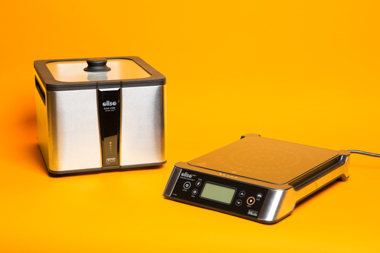
Immersion circulators—those magic wands that clamp onto a pot and hold the water at a precise temperature—have been burning up the kitchen scene in recent years, giving home cooks the chance to affordably incorporate the previously pros-only technique known as sous vide (pronounced soo-veed) into their repertoires.
I prepped my kitchen for testing and prepared to blow a fuse.
Read the complete WIRED review here. (Photo Josh Valcarcel/Wired)
Kitchen and Bar Gear That’ll Make You Want to Stay Home for Dinner
WIRED - Gadget Lab - Tuesday, November 11, 2014
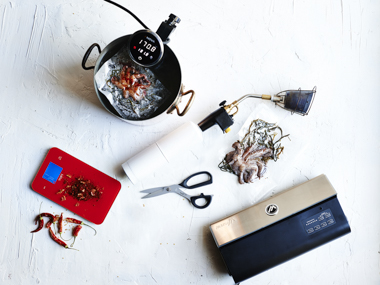
A roundup of the tools made to make your tiny kitchen more efficient and everything you need to cook sous vide.
...
Click here to read the story in WIRED.
This Fiery Tool Finishes Your Meat With a Blast of Heat
WIRED - Gadget Lab - Thursday, October 30, 2014
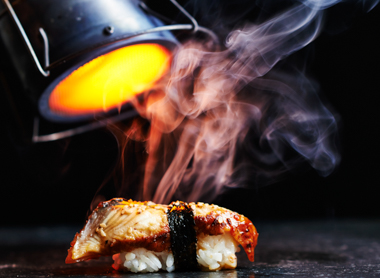
A few years back, on a walk among the spice shops and bodegas of Manhattan’s Chinatown, I spied a storefront that looked like it was owned by a hard-drinking chemist. Fernet and Aperol commingled with beakers, pipettes, and books—stacks and stacks of books. I knocked on the door to ask what they did.
I received a polite but vague answer about doing research for a bar. A more appropriate answer might have been, “We’re schemingâ€â€”especially when you consider that what eventually emerged from the man’s mind is the Searzall, a baffle that fits over the business end of a blowtorch to spread out the heat, turning your BernzOmatic into a handheld broiler.
Click here to read on and get the perfect sear.
Review: iDevices iGrill2 - Controlled Burn
WIRED - Gadget Lab - Monday, June 2, 2014

A FEW WEEKS ago, I was invited to a dinner where I volunteered to grill a pork tenderloin. Clever me, I brought my own thermometer to monitor the meat so we could sit down to gorgeous, rosy-centered discs of pork goodness.
Except it didn’t work out that way.
The grill—a beefy Weber—wasn’t the problem. The problem was me. I kept popping in and out of the house to keep an eye on things—inside to shoot the breeze and outside to check the temperature. I’d come back in, have a sip of beer, try to figure out what everybody was talking about then my phone timer would go off.
“That’s the pork calling!†I joked, running back outside again, trying to do two things at once, but doing both badly.
The iGrill2 would have solved this problem.
Read the full WIRED review here.
(Photo: Courtesy iDevices)
Squeeze Play! Reviewing Hurom’s HH Elite Series Slow Juicer
WIRED - Gadget Lab - Wednesday, May 7, 2014
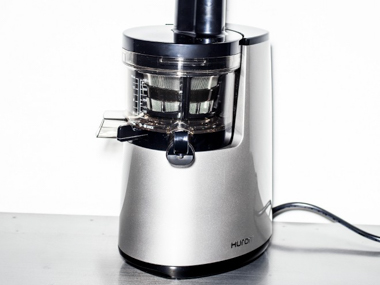
Last fall, I spied a box that read “FREE JUICER†on the stoop of a neighbor’s house. Inside, I found a decades-old Champion Juicer—an industrial-looking thing that pronounced itself the “World’s Finest Juicer†right there on its aged decal. I’d seen these $265 beauties in restaurant kitchens where I’ve worked, like Washington State’s Willows Inn where hot-shot chef (and James Beard Rising Star Chef of the Year award-winner) Blaine Wetzel uses a Champion to make a juice pairing option to accompany the prix fixe meal. I tucked the Champion under my arm and went home, where I had a tree’s worth of apples that needed attention.
I gave the apples a bath, chopped them into wedges, loaded them in the hopper, and pushed them down into the Champion’s spinning blade and auger combination, which instantly reduced them to juice and compost. The machine was beefy enough that I considered hauling it out to the backyard and using it as a wood chipper.
Now an avid juicer, I was eager to test a new high-end Korean model called the Hurom HH Elite Series Slow Juicer. When it arrived at my door, the first thing I noticed was the Champion-like weight, thanks to a motor that could probably crank my Subaru on a cold day.
...
Click here to read the story on WIRED and learn if the Champion was ... the champion or if it was vanquished by the Korean upstart.
Review: The Nomiku Immersion Circulator—A Sleek Magic Wand That Makes Sous Vide Easy
WIRED - Gadget Lab - Thursday, March 20, 2014

Before a hot new kitchen gadget called the Nomiku hit the market, a buddy of mine and I had a running joke about how much it looked like a sex toy. When the box arrived, we realized how right we were.
No, it doesn’t vibrate. The Nomiku is an immersion circulator, a wand which, when placed in a pot of water, can hold a constant pre-set temperature for a long time, allowing the low-and-slow heating of food inside a vacuum-sealed plastic bag, a technique known as sous vide cooking. With it, tricky cuts of meat become fork-tender, steak can be medium rare from top to bottom and fish can be cooked to the perfect temperature without going over the edge.
Read the full WIRED review here to see how it stacks up against the competition.
(Photo: Jim Merithew/WIRED)
For Home Chefs on a Budget, Sous Vide Cooking Heats Up
WIRED - Monday, November 18, 2013
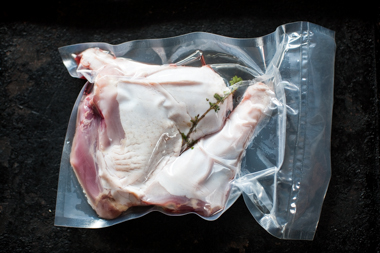
When working with the right kind of foods, a sous vide machine is like an appliance from the Jetsons kitchen. Six-pound pork shoulder cooked medium-rare all the way through and fall-apart tender? No problem! Entire salmon filets that maintain near translucency from end to end? Piece of cake! Scallops that don’t overcook? We can do that!
At least now we can. Formerly the realm of the deep-pocketed kitchen nerd, sous vide cooking — where food is sealed in an airtight bag, then heated at a low and steady temperature — has become more accessible with the arrival of some lower-priced cookers.
Read reviews of the Anova, Sansaire, Polyscience and SousVide Supreme models here on WIRED.
The Best Pho in Vietnam
The Wall Street Journal - Off Duty - Friday, October 18, 2013

MY FIRST LESSON in pho came during a jet-lagged breakfast the morning I arrived in Hanoi, the old-meets-new capital of Vietnam.
“Eat it now,” said my waitress, pointing to the bowl she had just set down. Firm as a general but polite as can be, she wanted me to know that the noodles in my soup would remain in their perfect state only for a moment.
...
Click here to read on and find out if Hanoi or Saigon has the best pho in Vietnam.
Along the Trail of Korea’s Mountain Spirits
The New York Times - Travel - Sunday, December 2, 2012

THE titanium spork was a Christmas gift from my brother Gregory, a choice that seemed random at the time. I had no use for ultra-lightweight dual-use cutlery. But nine months later, almost 7,000 miles from my home in New York City and nearly catatonic with exhaustion, I was thankful for its lack of heft. Gregory; my husband, Joe; and I had been hiking for 12 hours while hoisting a 30-pound backpack over steep and slippery rock in a thick mist. After nightfall, headlamps fading, we spotted dots of light below us in the dark, and heard the eerie whoosh of a wind generator. We stumbled down to the Satgat-jae shelter, a basic cabin for hikers perched at over 4,200 feet in South Korea’s Deogyusan National Park. I unpacked my spork.
...
Story by Elisabeth Eaves, photos by Joe Ray. Read it here in the New York Times.
Making The Most of a Hong Kong Layover
The Boston Globe - Travel - Sunday, November 25, 2012
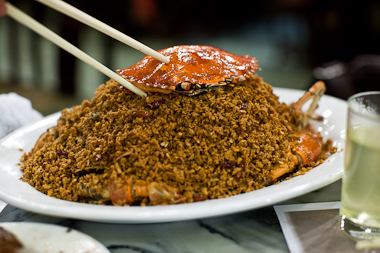
We emerge from Central Station’s underground taxi stand, scooting along in a boxy, red Toyota Crown Comfort cab, complete with remote-controlled rear door openers and de rigueur custom gearshift knobs, and plunge Space Mountain style into daylight among the skyscrapers.
We’re on a tight schedule. For my girlfriend, Elisabeth, and me, Hong Kong is two 10-hour layovers bookending an Asia trip, but we’re after more than that schedule should reasonably allow. Before hopping into the cab, we had parked our bags at the airport and taken an 80-mile-an-hour train ride into town. I had put the word out to friends and colleagues that we would need help to get the most out of our visit. While Anthony Bourdain might have a fleet of specialists to plan his visits for his television show “The Layover,†we had a guy named Nelf…
Read the story and see the photo album here in The Boston Globe.
Luang Prabang Lights Up The Senses
The Boston Globe - Travel - Sunday, November 4, 2012

Story & Photos by Joe Ray
The monks and novices appear a block away under a streetlight, arranged by age and, roughly, by height. In the early light, their orange robes glow near-fluorescent. The only sound is the padding of their bare feet.
I sit across from a pair of women, sashes over their left shoulders, one pregnant, the other elderly, seated on mats on the sidewalk. The monks chant together, then file in front of the women, each receiving handfuls of sticky rice in their begging bowls as part of a charitable act that is said to feed the spirits of their ancestors and build merit in a future life.
For a sleepy little town, Luang Prabang can light up your senses in a heartbeat.
Here, scooters, cars, and tuk-tuks — the three-wheeled motorized vehicles used as taxis — putter through town as if the speed limit were 20 miles an hour. Life moves slowly, and there’s an openness of emotion, from the nervous tug at the hem of a woman who is seeing her family off at the airport as we arrive, to the smiling children we meet one afternoon who, instead of making peace signs or goofy faces when they pose for a picture, put thumb to thumb and fingers to fingers, making a heart with their hands. If this town were a person, it wouldn’t have a mean bone it its body.
Find the whole story and photo album here.
Tequila, A Quintessential Mexican Town
The Boston Globe - Travel - Sunday, October 21, 2012

Just beneath the angel statue at the front corner of the town square, a young girl in a frilly lavender dress runs through a swirl of soap bubbles, her arms outstretched, a magic wand waving above her head. Her smile is so large, it’s like the first time a child sees snow. Above her rises the rough stone facade of the Santiago Apostol church whose tower is topped by a great neon cross with a tiny heart at its center.
The deliciously sleepy town of Tequila — population 30,000 — is quintessential Mexico. At first blush it’s hard to imagine that it is at the center of a big industry, yet the city’s coat of arms is festooned with the agave plant used to create the spirit that is the economic heart of the region.
Here, men wear cowboy hats, Wrangler shirts, jeans, and boots, and children scramble freely through the streets. Much of the town is surrounded by distilleries such as Cuervo and Sauza. Beyond them are thousands of square miles of the spiky, blue-tinged agave plant whose middle, known as the piña for its pineapple shape, is cooked and crushed to create the juice that is distilled into Mexico’s national spirit and is a big favorite north of the border.
Find the whole story here - in the Boston Globe.
Chef On The Rise
NUVO Magazine - Fall 2012
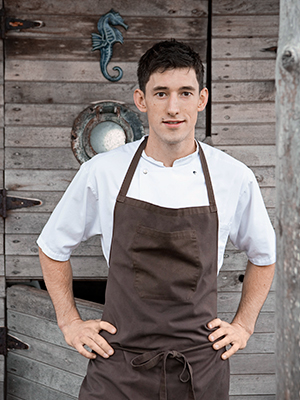
The owner of the tiny, far-flung island inn in Washington state posted a Craigslist ad seeking a seasonal chef. Across a continent and an ocean, it caught the attention of a young cook seeking to make his mark.
Blaine Wetzel was in the middle of a year as a chef de partie at Copenhagen’s Noma, a restaurant that had just hit full stride and was about to be named to the top spot on S.Pellegrino’s World’s 50 Best Restaurants list for the first time. Say what you will about restaurant ranking systems—it made for a great starting point in negotiations.
Read the story here.
Shrub It Off
The Daily - Sunday, July 29, 2012
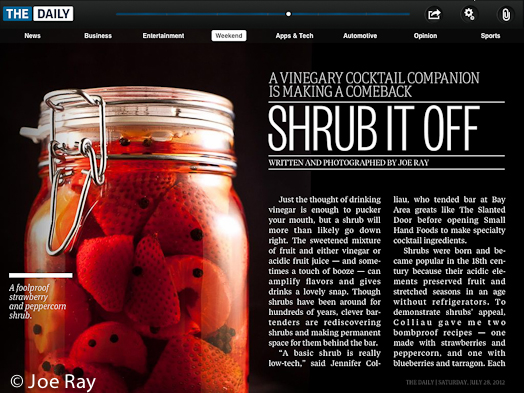
Just the thought of drinking vinegar is enough to pucker your mouth, but a shrub will more than likely go down right. The sweetened mixture of fruit and either vinegar or acidic fruit juice — and sometimes a touch of booze — can amplify flavors and gives drinks a lovely snap. Though shrubs have been around for hundreds of years, clever bartenders are rediscovering shrubs and making permanent space for them behind the bar.
Read more here in The Daily
On an island off British Columbia, fishing and remembering
The Boston Globe - Travel - July 22, 2012

LANGARA ISLAND, British Columbia — The clouds and mist rendered the ocean’s surface indistinguishable from the air above. Below, a school of dark, inch-long needlefish was driven upward by predators, a crossover between worlds that looked like inky rain emerging from the sea.
We were a group of seven fathers, sons, and friends from Atkinson, N.H., who came to the Haida Gwaii, a nearly uninhabited archipelago off British Columbia’s west coast, to try some of the best sportfishing in the world. We were here to celebrate a friend. Our hometown hero, Marine Major Jeremy Graczyk, 33, died a year ago in an off-duty parachuting accident that sent his family into the lonely hell of losing their only son.
When it happened their relatives, friends, and community closed around them, trying to help with food and drink, space and companionship — all of which we hoped would be with us in abundance in Canada.
Read more here in The Boston Globe
Fresh Direct
The Daily - Saturday, July 14, 2012

The helicopter flight north from Masset, British Columbia, floats over the remote wilderness of the Haida Gwaii. The archipelago’s thousands of acres rest quietly off the coast of British Columbia, just south of Alaska. For local fishermen, however, the catch comes in, reels screaming.
Formerly known as the Queen Charlotte Islands, the Haida Gwaii are “Land of The Lost†wilds with a human population under 4,000. Along the shore, fish arrive by the millions. Lingcod, rockfish and salmon — chinook, coho and pink — gorge themselves on masses of baitfish. The local halibut can grow to more than 100 pounds.
Chef Walter Pelliccia has had his pick of the freshest fish in the world for more than 20 years at North Island Lodge, one of a handful of fishing lodges that dot the coast of Langara Island, the northernmost dot of the Haida Gwaii.
“This is the cleanest water you’ll find anywhere,†said the Italian-born chef of his stretch of the Pacific. “The Dungeness crab you get here makes what you find in Vancouver and Seattle taste like crap.â€
Pelliccia rattled off a laundry list of easy-to-access seafood — a supply to make any chef jealous.
Read more here in The Daily
In Laos, The Lady and the Jars
The New York Times - Friday July 13, 2012 - Story by Elisabeth Eaves, Photos by Joe Ray

By Elisabeth Eaves - Stuffed with passengers and piled high with luggage, our minivan careened down a twisting mountain road, descending across northern Laos. The spot where I got carsick, I later learned, was precisely where the unfinished French colonial road had reached its westernmost end in 1932.
That year, an archaeologist named Madeleine Colani took refuge at the road works encampment there, where a Monsieur Ruffet presided over the construction of Route 7, which would run from Hanoi, the capital of French Indochina, to the royal city of Luang Prabang on the Mekong River. Though Monsieur received Mademoiselle and her crew amiably, troubles awaited them at his camp that far exceeded my own temporary discomfort…
Read more here in The New York Times.
Craft Tequila: Small Producers Bring Value and Originality
The Chicago Tribune - Food - Wednesday July 4, 2012

Not too long ago, tequila was a second-class spirit in America. On my first-ever trip to Mexico — an early 1990s college jaunt to Tijuana — a waiter grabbed my friend Eric’s head, tipped it back and poured tequila straight down his throat before shaking him by the shoulders and popping a lime wedge in his mouth.
That was par for the course for America’s perception of Mexico’s national spirit. Flash-forward to the present day, however, and tequila’s major labels have brought about an overhaul, a strong and steady rise in quality and image.
Some say the better products from big producers like Cuervo and Patron have been polished to the point that they’ve rubbed off a bit of tequila’s soul. Their progress, however, has paved the way for the little guy — lower-volume producers unafraid to push the envelope and make stuff that is worth the extra effort it takes to find a bottle of it.
Read more here in The Chicago Tribune
The Street-level Tasting of Tequila and Its Cousins
The Chicago Tribune - Travel / Fork In The Road - Tuesday July 3, 2012

GUADALAJARA, Mexico — In all my days of writing, I’ve never ended up on the dance floor with an interviewee as quickly as I did in Guadalajara, in west-central Mexico.
Stefano Francavilla and his sweetheart, Paula, picked up my wife, Elisabeth, and me in their red beater of a car, and we shot into the heart of the city. We had a long flight to Mexico, so they knew we’d be hungry and took us to the Ta Corte taco stand, a meat lover’s paradise where we tried a vampiro, cubed bits of steak atop a layer of cheese grated directly onto the grill, making something of an overstuffed taco topped with a choice of salsas. It would be disgusting if it weren’t so darn good.
“After this, I’m not eating meat for a week,” said Elisabeth, before leading the Clean Plate Club charge.
While we munched away on a metal bench, four guys in front of us plowed through their tacos, standing on the street and using the spoiler on a Ford Escort as their countertop.
“This is the place you come to before or after you drink to ward off a hangover,” said Francavilla, an Italian transplant who helps run the tiny Calle 23 tequila company (tequilacalle23.com) with its founder, Sophie Decobecq.
We cleaned up and took off again, eager to make the most of the city that serves as the gateway to the tequila and mezcal industries.
Read more here in The Chicago Tribune.
No Way José (Cuervo)
The Daily - Saturday, June 23, 2012

TEQUILA, Mexico — While tequila’s “lick it, slam it, suck it†mentality will never go away — how could it? — the spirit’s growth among smaller, handcrafted brands made for slow sipping is soaring. According to Mexico’s National Chamber of the Tequila Industry, there were about 35 tequila producers two decades ago and now there are 159, many of them boutique brands.
Big tequila brands like Sauza, Cuervo and Patron have led the charge, maintaining their base while steadily building up tequila’s image. They pushed quality, steering connoisseurs away from low-quality mixtos and toward “100% de agave†— made entirely from the tequilana Weber blue variety of agave. The big guys also expanded the use of barrel aging, breaking with the idea that tequila should be downed in one shot or used as a mixer. As the demand for quality tequila grew, larger brands spun off sub-brands (Cuervo Silver, Patron XO Cafe); the door was open for the kinds of small producers that are becoming increasingly popular in the United States.
Guillermo Erickson Sauza, who runs Tequila Fortaleza, might be the best embodiment of Tequila’s new wave. The Sauza side of his family (his mother’s) founded Sauza in 1873, but his grandfather sold the name and most of its holdings in 1976.
After a long stint in the corporate world, Erickson Sauza fired up the museum-like Fortaleza distillery and realized he had something extremely promising. His pair of stills, at 400 and 250 liters, are several times smaller than what most bigger brands use, but he didn’t touch a thing.
“That first batch was good but we had no trucks and no place to put it,†he said, sporting his trademark cowboy hat and Hawaiian shirt. “The learning curve’s straight up.â€
Read more here in The Daily
Great Dane - Mads Refslund’s Acme Restaurant
The Daily - Saturday, June 9, 2012

Many chefs flash a mention of a brief experience at Copenhagen’s Noma, aka the world’s top-rated restaurant, as an obligatory badge of honor. Mads Refslund can top that: He founded it.
Co-founded, actually, and while he and chef Rene Redzepi worked together, pioneering New Nordic cuisine and its mission of cooking the best of what’s just outside your door, the old saw about taking two to tango doesn’t apply to kitchens. The two parted company amicably after less than six months, and Refslund went off to start the well-respected MR, a Copenhagen hot spot that garnered a Michelin star in its first year.
Refslund has now found a home at Manhattan’s Acme, which doesn’t have MR’s high style but offers its own ambitious kind of art. He appeared on the American dining scene without fanfare, and despite the Noma connection he’s wisely downplayed the move to give himself time to break in his shoes before the impending sprint.
Read more here in The Daily
Good Morning, Viet-Nosh
The Daily - Saturday, May 26, 2012
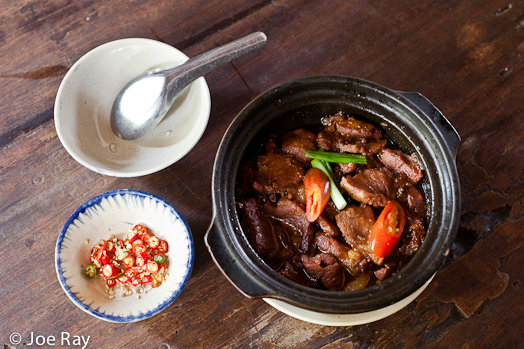
Some 16 million people live in Hanoi and Saigon, and walking through the mind-boggling traffic in these cities, you get the distinct impression that if you sat on any given corner, you’d see them all go whizzing by on scooters making their way toward lunch. Day and night, north to south, this is a nation of serious eaters, and its two biggest cities are the perfect spots to get a handle on Vietnam’s food scene — provided you know the places to hit and what to get.
Read more here in The Daily
Data On The Menu At Your Favorite Restaurant
WIRED.COM - Thursday, May 3, 2012
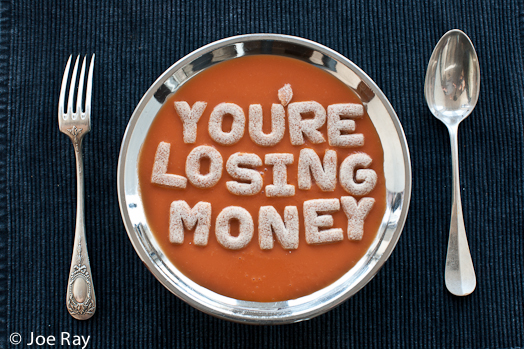
NEW YORK — Timothy used to be struggling at work. He’s a waiter at the Landmarc restaurant at the Time Warner Center, a classy-but-accessible eatery that serves bistro fare to Manhattan shoppers. By some measures Timothy has always been a great worker — he clocks in on time and never forgets an order. But his sales of beverages and side dishes were falling short last year.
In one month, Timothy (not his real name) served 426 customers, pulling in $17,991.50 in gross sales with a per-check average of $42.23. That’s $3.84 below the overall per-check average at the Landmarc. It turns out that while Timothy was beating the rest of the waitstaff in add-on sales like bacon or cheese on a burger, he was lagging 2 percent behind everybody else in red wine and liquor sales, and a whopping 14 percent behind his peers in sides like French fries and creamed spinach.
The bottom line was $1,636 of lost sales opportunity in a month — the money Timothy would have made if he’d hit the server average.
We know all this because every item sold at Landmarc — down to the last malbec, martini and red quinoa pilaf — is individually logged and enumerated by a sophisticated software package called Slingshot. The software slices, dices and crunches the data every night, and then serves it to managers with breakfast the next morning.
Read more here in WIRED.COM
Natural Selection - Matthew Lightner’s Atera
The Daily - Saturday, April 28, 2012
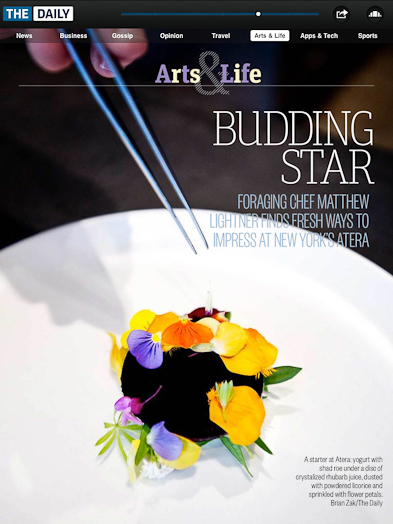
The well-groomed man who met us at the door of the new restaurant projected an aura of unflappable confidence, but something was amiss. He ushered us into an elevator that brought us to a tiny downstairs room lined with cookbooks, and explained that the health inspector had arrived for a surprise visit. He asked if we wouldn’t mind waiting a few moments to go upstairs, and poured a glass of bubbly for our trouble.
Routine health inspections are a headache for any restaurant, but the greater scrutiny of New York City’s ultra-hyped Atera will come from the public. Chef Matthew Lightner, 31, is making a big bid with his move from Castagna in Portland, Ore., where he wooed the local crowd with a philosophical, artistic style of cooking previously unseen in those parts. Manhattan, however, marks Lightner’s entry onto the world stage.
Read the rest here in The Daily…
Round by Round - Paris Cheesemongers Ply Their Trade For The Faithful
The Boston Globe - Sunday, April 15, 2012
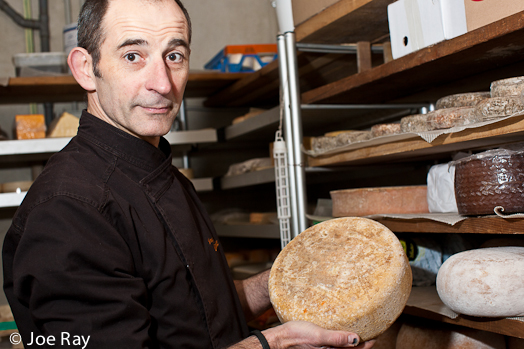
I am famous for my cheese nights. An invitation goes out about a week or two in advance reading, “Bring a friend, bring wine, and bring a hunk of good cheese.†Even in France, where I have lived on and off for 10 years, I am famous . . . at least among my friends.
Cheese night started when I lived in Seattle as a way to connect to France, where I wanted to make my home. The tradition continued and grew exponentially at my apartments in the City of Light, where tables would be mounded with cheese and wine. At one of the first of these gatherings, a friend popped a bite of baguette laden with a wonderfully runny Vacherin Mont d’Or and proclaimed, “This tastes like I’m licking a cow’s rear end!†before going on to eat the rest of the wheel himself.
...Read the rest here in The Boston Globe Travel.
Dust Off The Bottle
The Daily - Arts & Life - Saturday, March 17, 2012

At Brooklyn’s Palo Cortado tapas bar, owner Alessandro Piliego was speaking his native Italian on the phone. Apparently, a native Roman slinging 20 sherries by the glass in the bowels of Brooklyn is what it takes to help kick-start a trend.
“Sherry isn’t popular and Spanish restaurants in the United States haven’t done a good job at promoting it. It’s like going to an Italian restaurant and not finding grappa,†he said. But sherry, the once-fusty Spanish wine, is enjoying a budding new regard stateside.
... read the rest here in The Daily.
Ain’t No Thing But A Chicken Wing
The Daily - Arts & Life - Saturday, February 4, 2012
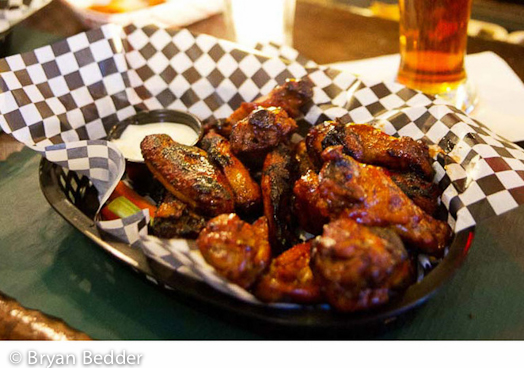
The last time I was in Buffalo, N.Y., my hair caught fire in a botched effort to down a flaming Dr Pepper shot at Mulligan’s Brick Bar. The only other thing I remember from that weekend is the chicken wings: flaming hot and particularly good with cheap beer. But what makes this quintessential football food so important to its hometown?
Andy Denne, chef at Allen Street Hardware, a rather perfect bar and restaurant in the historic Allentown district, had a few answers. Denne is a Buffalo native and a journeyman chef, but only on special occasions does he whip up wings, making him a neutral insider in the wing wars.
I called him to ask if it was worth making a winter trek to his city for Buffalo wings.
“First of all, we just call them wings, and I wouldn’t eat wings anywhere outside of western New York state,†he said. “C’mon up, man!â€
... read the rest here in The Daily.
Lost In The Jungle
Go Magazine - February 2012 - Story by Elisabeth Eaves, Photos by Joe Ray

BY ELISABETH EAVES — The sun has set since we entered the jungle, leaving us in total blackness except for the beam of light from José‘s head lamp, which bobs over vines and trees. As we ascend a rise, I notice square stones emerging from the black ground around us, stacked into low, uneven walls.
“What’s this?” I ask José, our teenage guide, who we rustled up from the nearest village. “A Maya structure,” he says, without breaking stride.
“Does it have a name?” I ask. “No,” he says. It doesn’t.
When we climb another rise where tree roots embrace tumbleddown walls, I ask again. Also Maya, he says, also nameless. José knows his birds and beasts, and he finds the jungle so peaceful that he spends weeks at a time camping out. No surprise, then, that he’s much more interested in showing us a small cane toad, which he stoops to capture from a puddle. He holds it in the light so that we can see its yellowish skin and blinking eyes. When threatened, cane toads excrete a toxin from certain glands, which some historians think the Mayas used as a hallucinogen, consuming it by licking the skin.
The presence of semiintact buildings more than 1,200 years old, barely buried just a couple of miles from his home, is humdrum to José.
Around here, the signs of ancient Maya civilization are everywhere, rising like ghosts from the ground…
Read more here in Go Magazine.
Extreme Vino - Canadian ice wine requires complex production, but yields sweet returns
The Daily - Arts & Life - Saturday, January 21, 2012
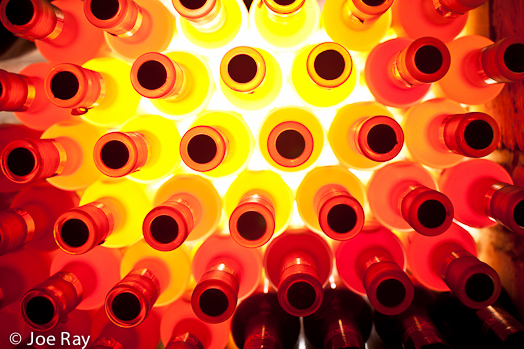
There we were, freezing our keisters off in Niagara-on-the-Lake, Ontario. The mercury had dropped well below zero, and the wind flung the snow so far sideways, it occasionally blew up at our faces from below the vines. We were a tiny group of harvesters, there to pick grapes in the name of Canada’s best gift to the winemaking world: ice wine.
We filled a few dozen bins with the brown frozen clusters of grapes, dumped them in the wine press and hit the switch. We peered in, waiting for the juice to appear between the wood slats and flow into the inch of snow that had accumulated at the bottom of the press. Nothing happened. It was a small amount of grapes, so we reconfigured the press and squeezed again. Still, not a drop.
... read the rest here in The Daily.
Blue-Plate Specials - Haute diners are making a continental comeback
The Daily - Saturday, December 31, 2011
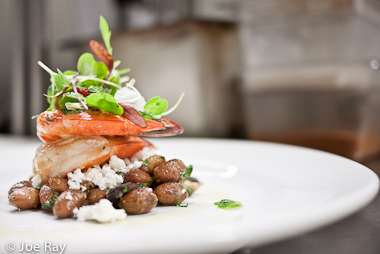
Walking into Vancouver’s Red Wagon, I spied one of the largest men I’ve ever seen. He had a twinkle in his eye, as if the waitress had just served him his favorite dish. Ever. Under his nose, a mound of buttermilk pancakes rose from an oval plate, interspersed with layer upon thick layer of pulled pork. Pinned to the side of the mound with a toothpick was a pair of butter pats. If a customer so wishes, he can also have a pair of eggs, sunny side up or over easy, atop it all for good measure. The man at the table certainly did.
Whether they have been around for a while, or are new spots simply conjuring an older ethos, a handful of diners across North America are shaking things up, putting smarter, better food on the Formica while keeping prices within reach.
... read the rest here in The Daily.
The History Page: Bling in a Bottle
The Daily - Saturday, December 31, 2011
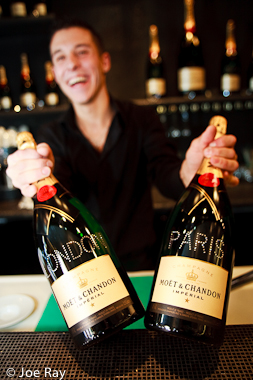
The Eiffel Tower and the snowglobe weren’t the only great legacies of the Paris World’s Fairs, though one of the longest-lasting icons spawned there resembles both. Louis Roederer’s Cristal champagne was the result of a meal hosted by Russian Czar Alexander II at the fair’s 1867 edition.
More than a century later, the wine’s history would bubble over into a controversy involving one of America’s richest MCs — a tale that began with some serious bling and ended with a boycott.
Cristal is arguably the most desirable bottle of champagne in the world, a pure status symbol. It’s what economists call a Veblen good — something like a Rolls-Royce or a Hermès Birkin bag, whose desirability increases with its price. That kind of exclusivity was exactly what Alexander II had in mind.
... read the rest here in The Daily.